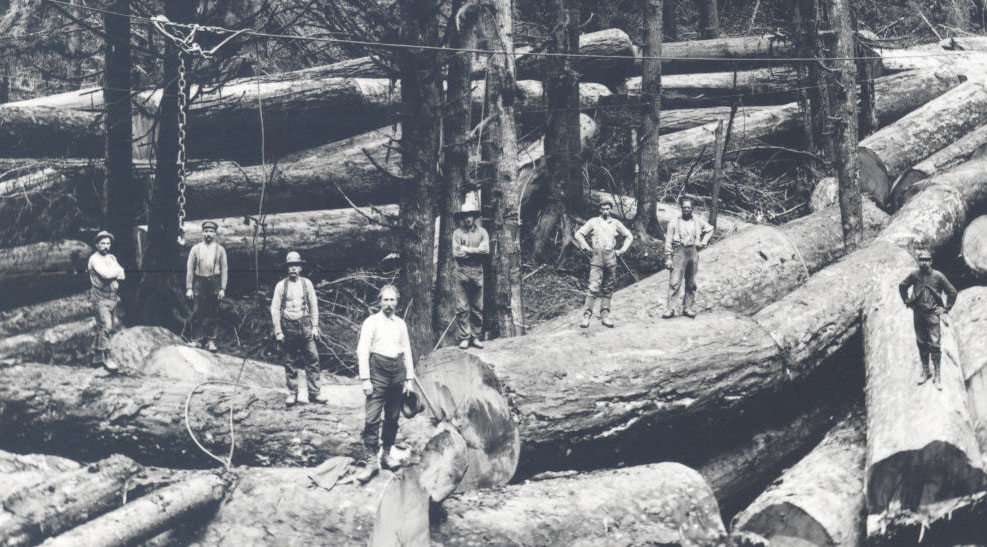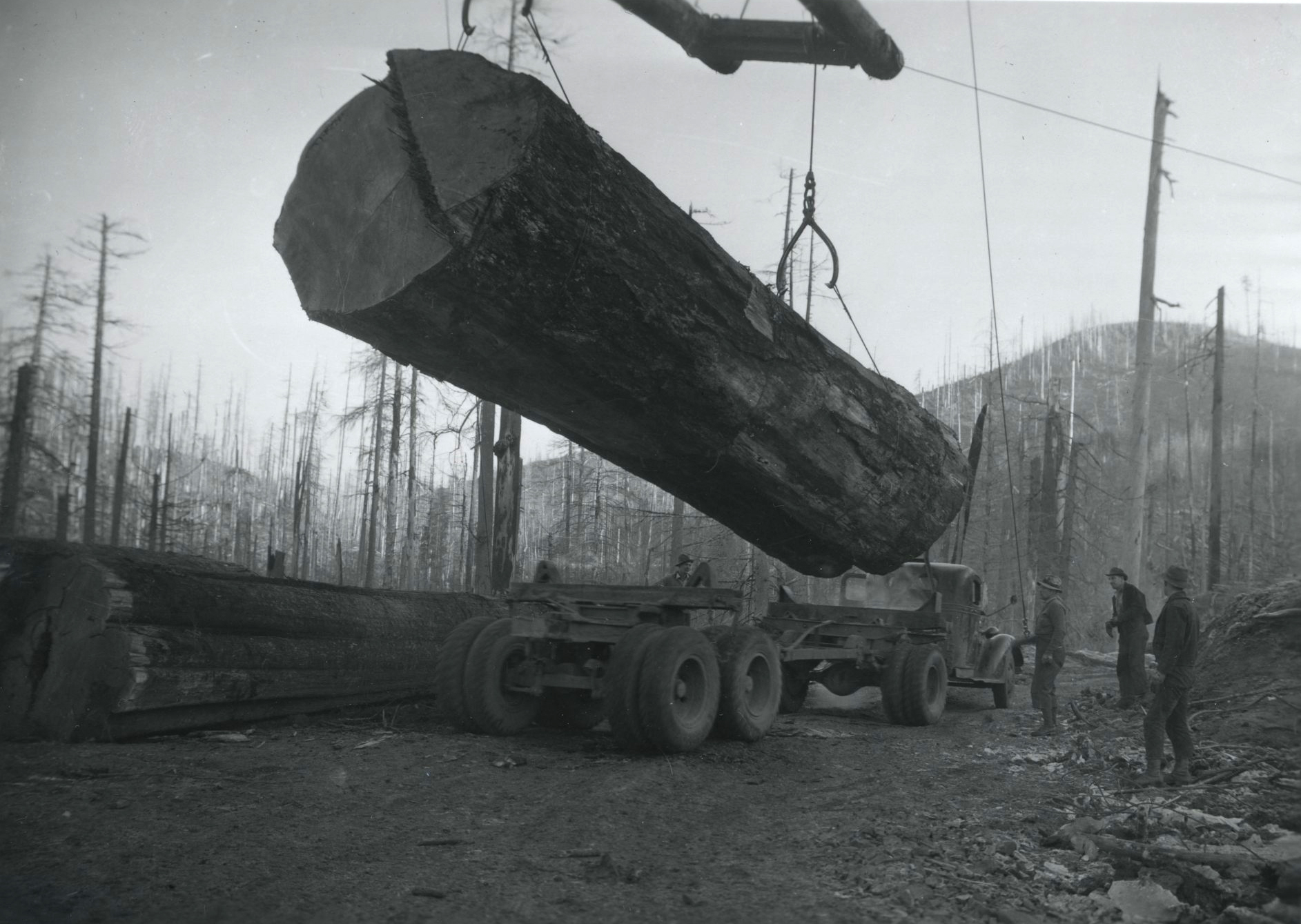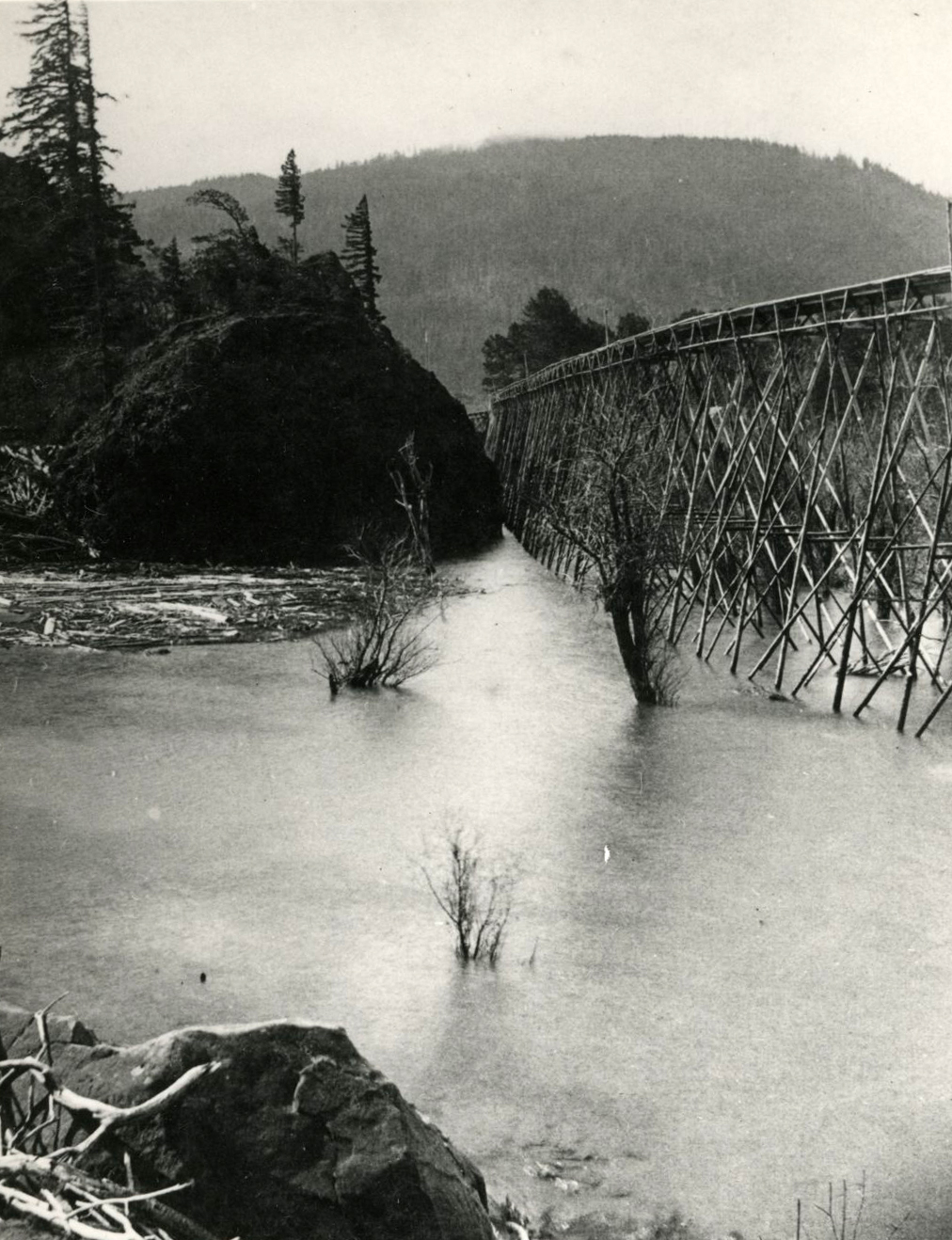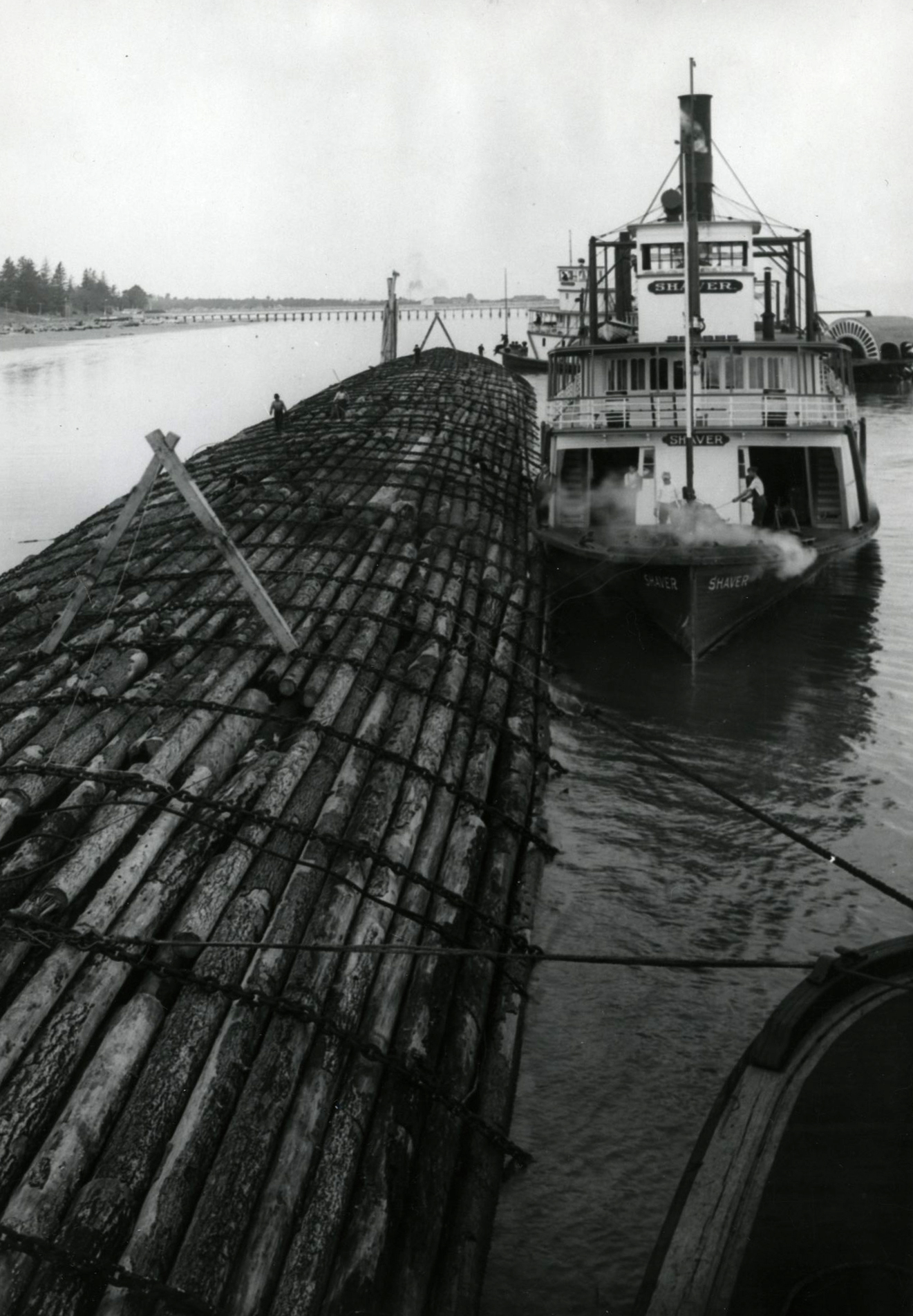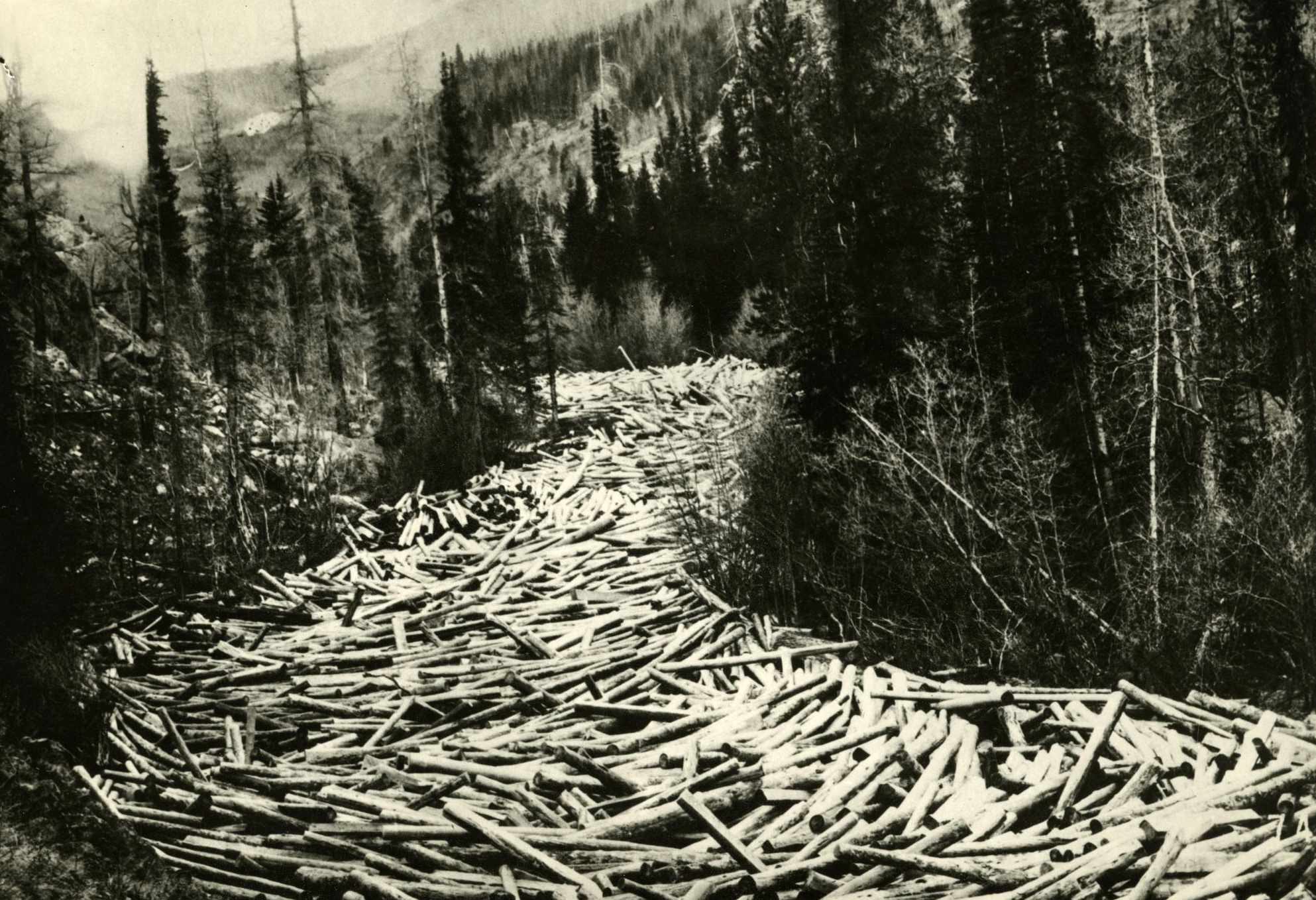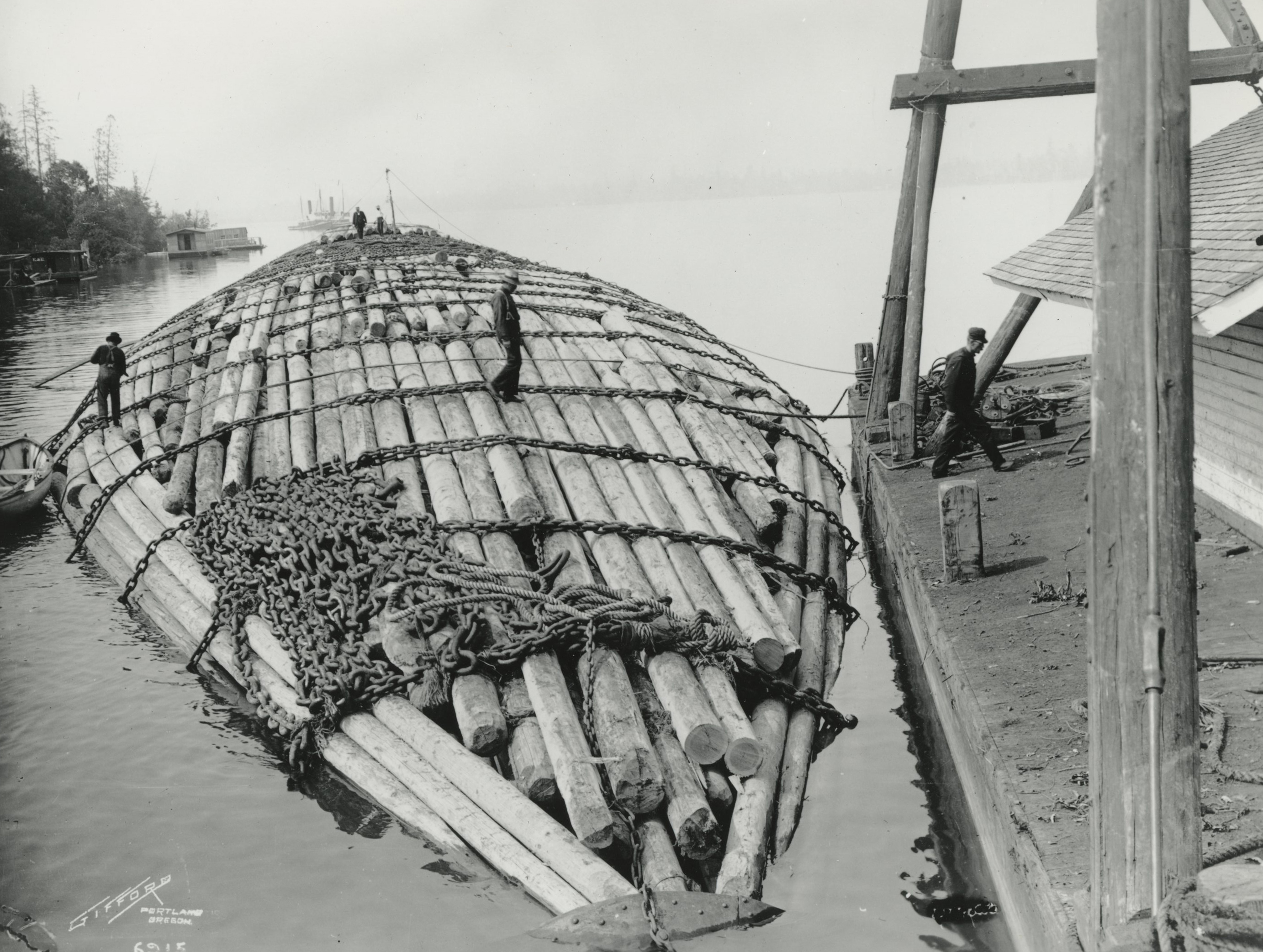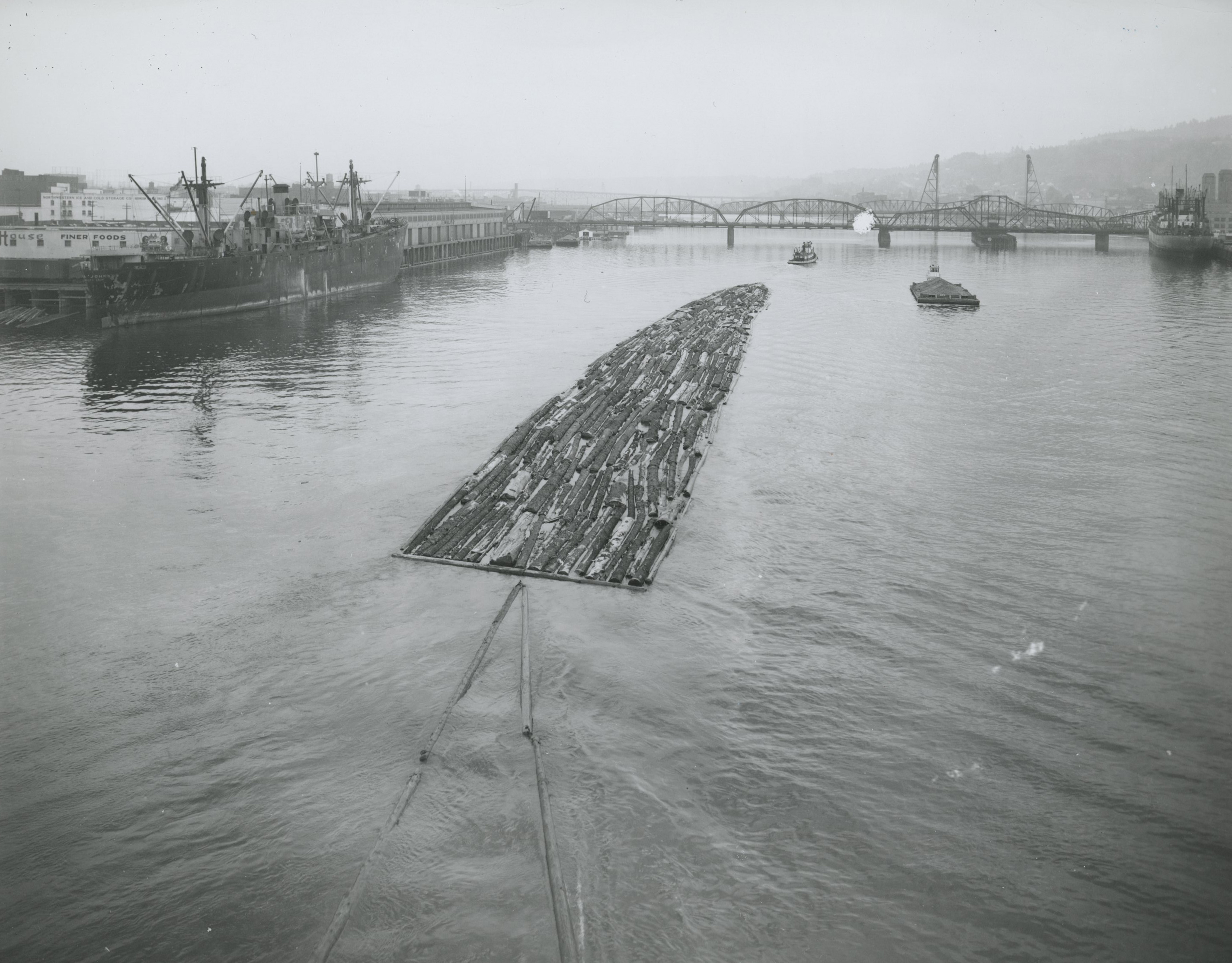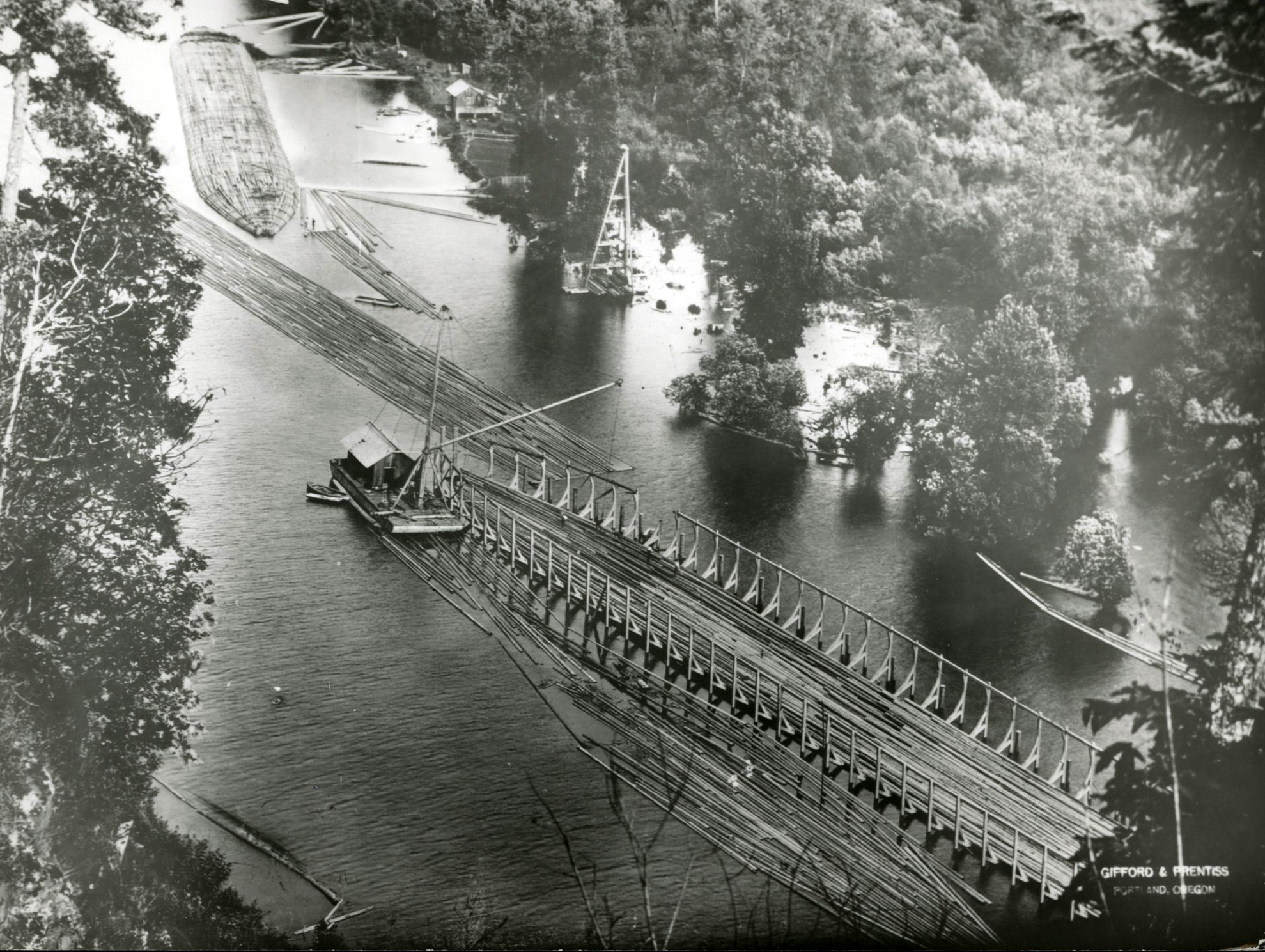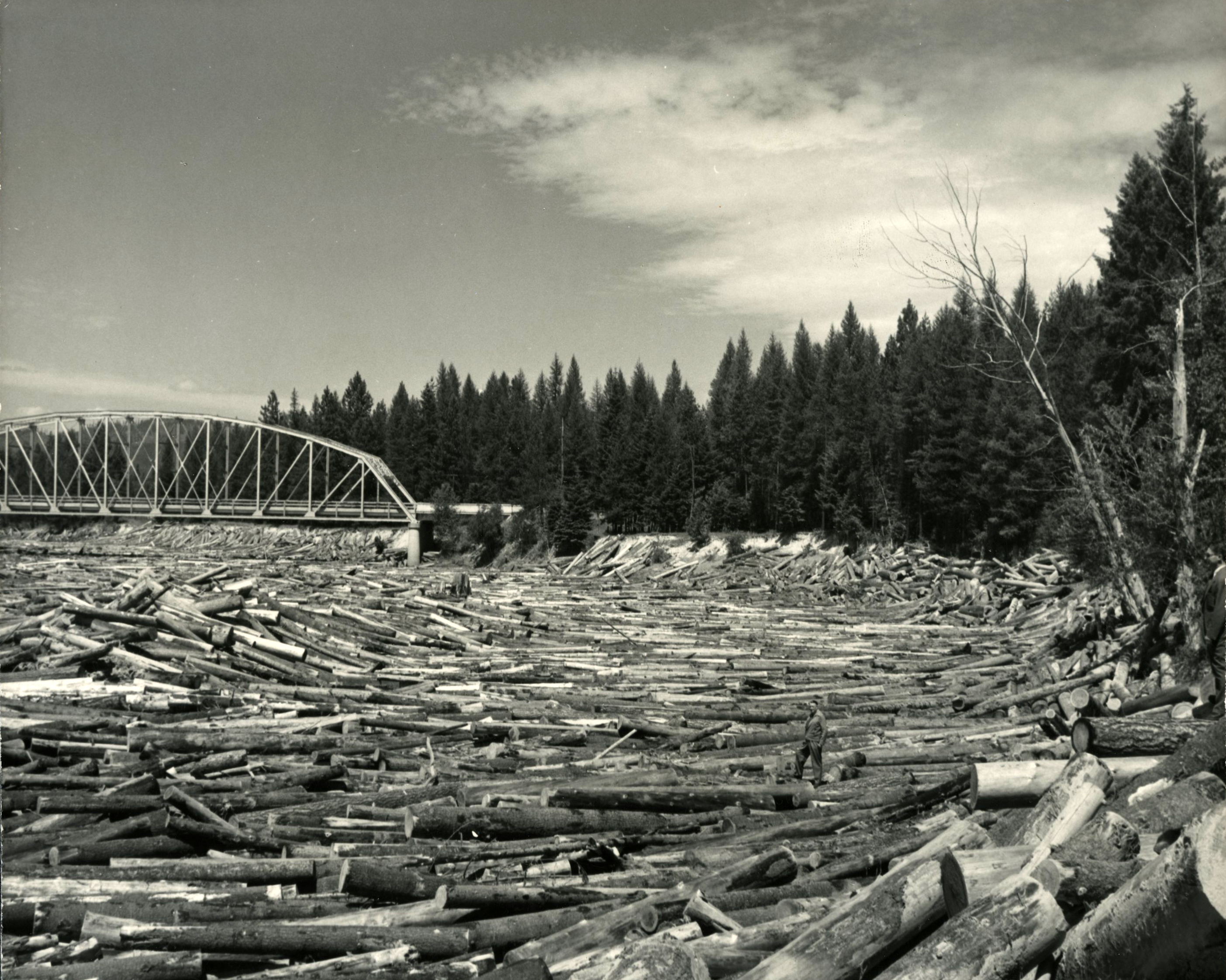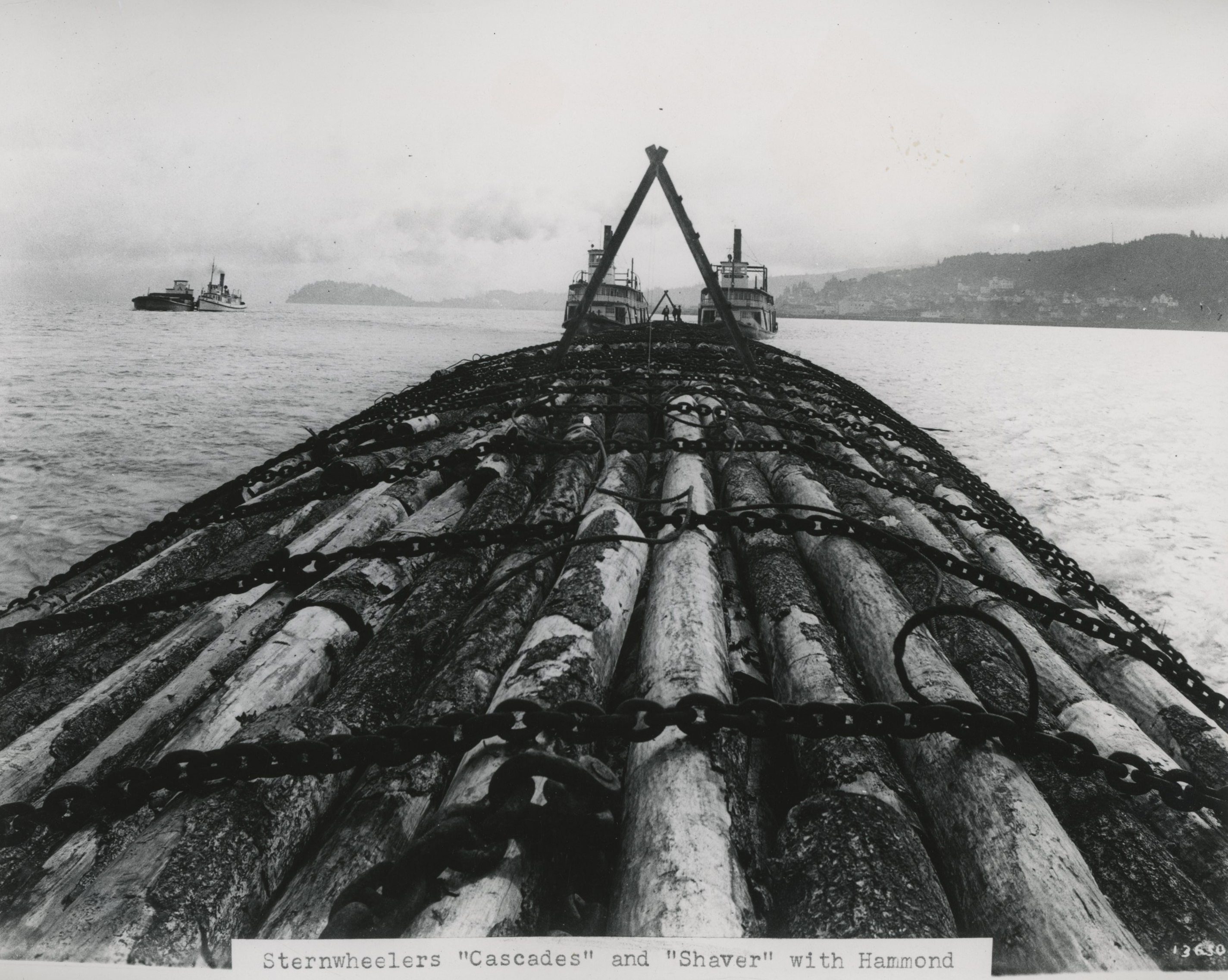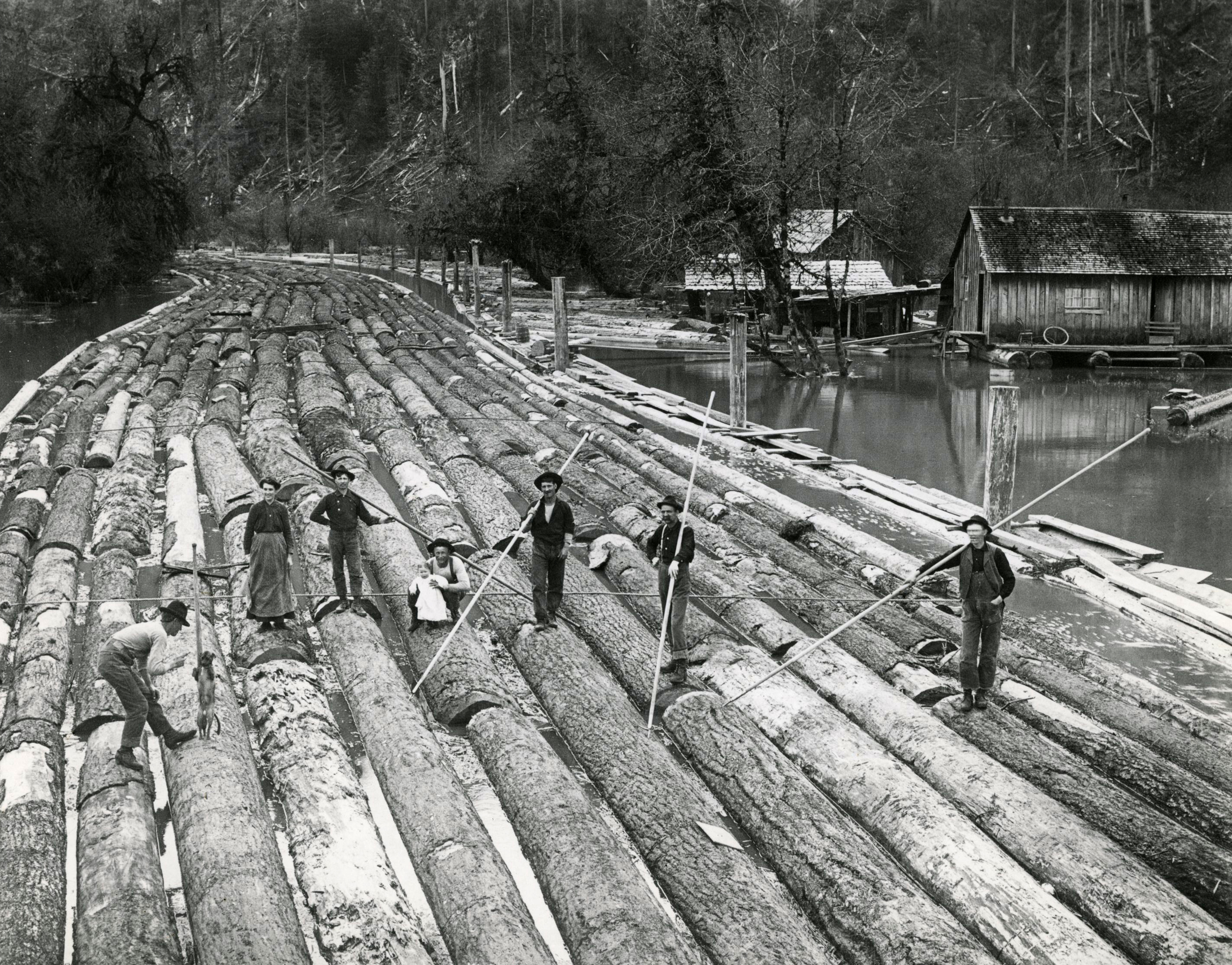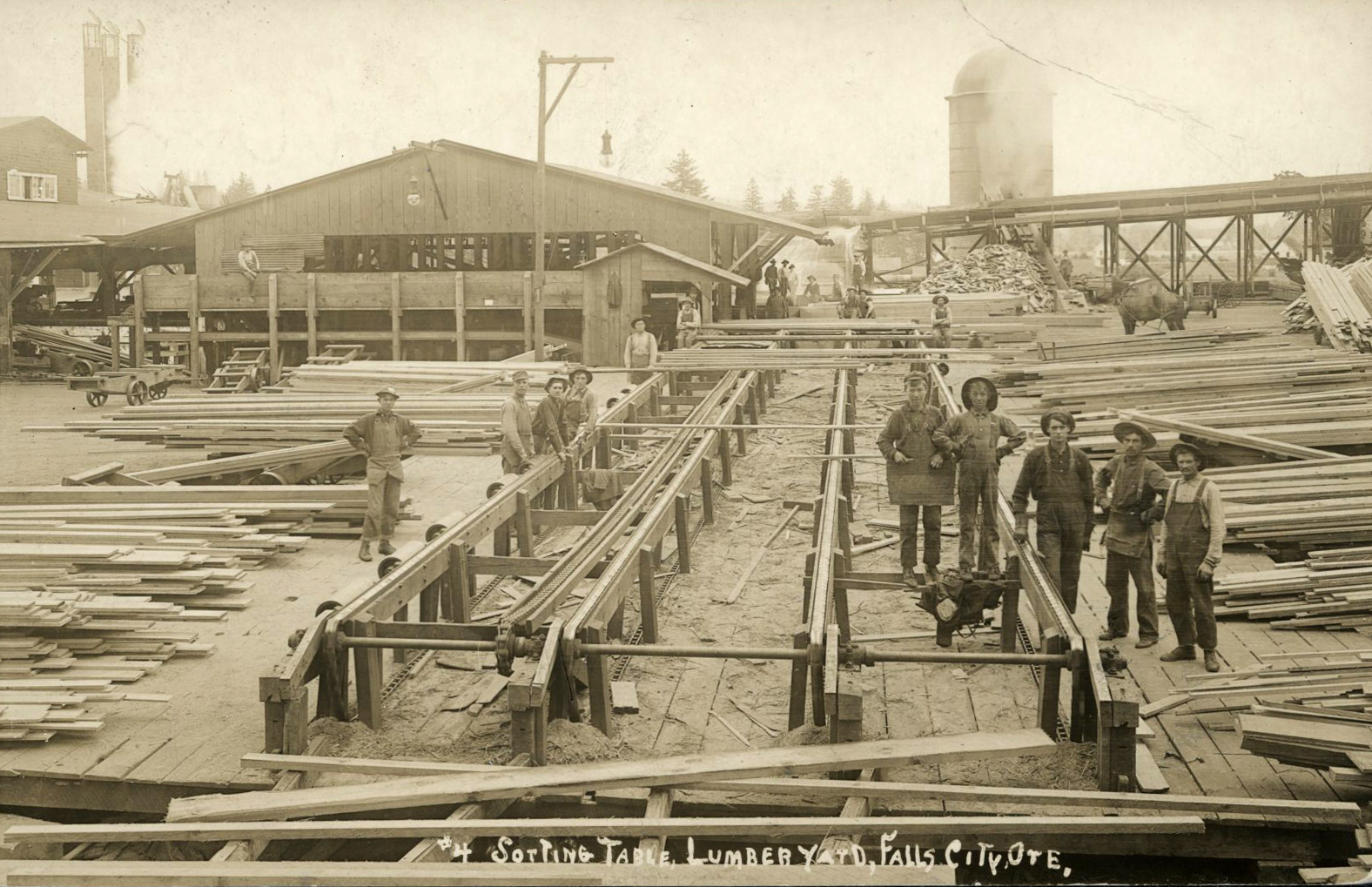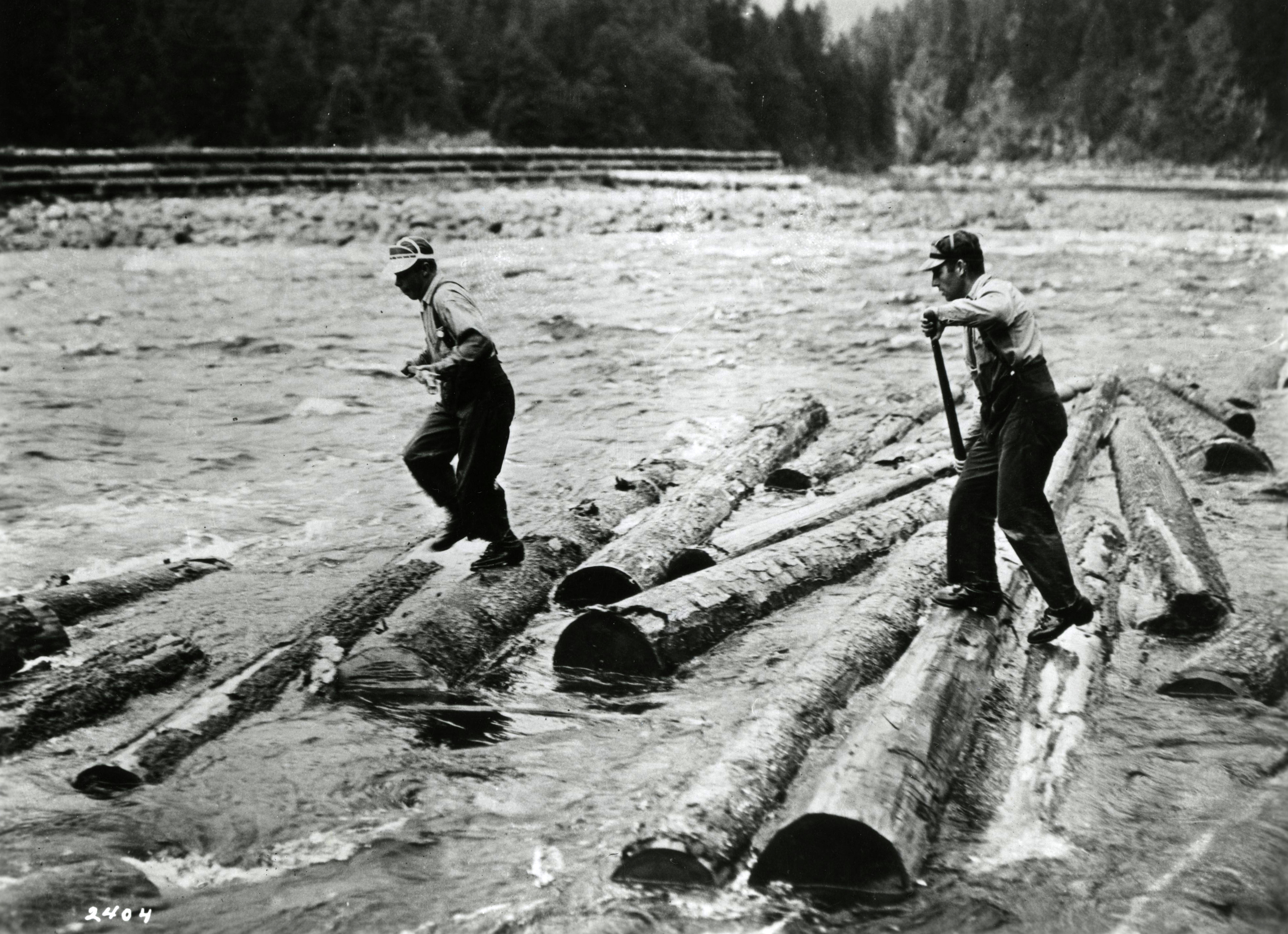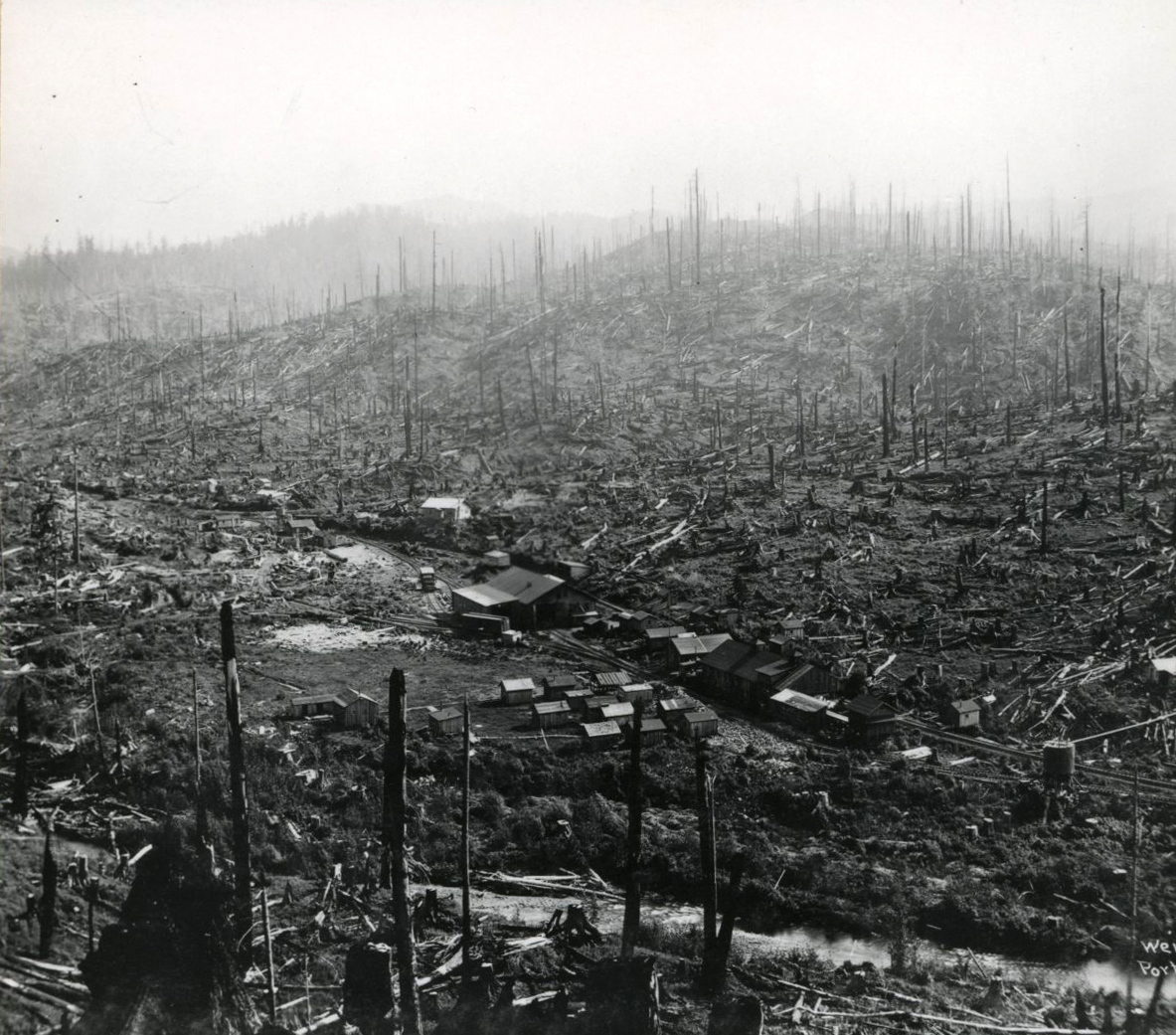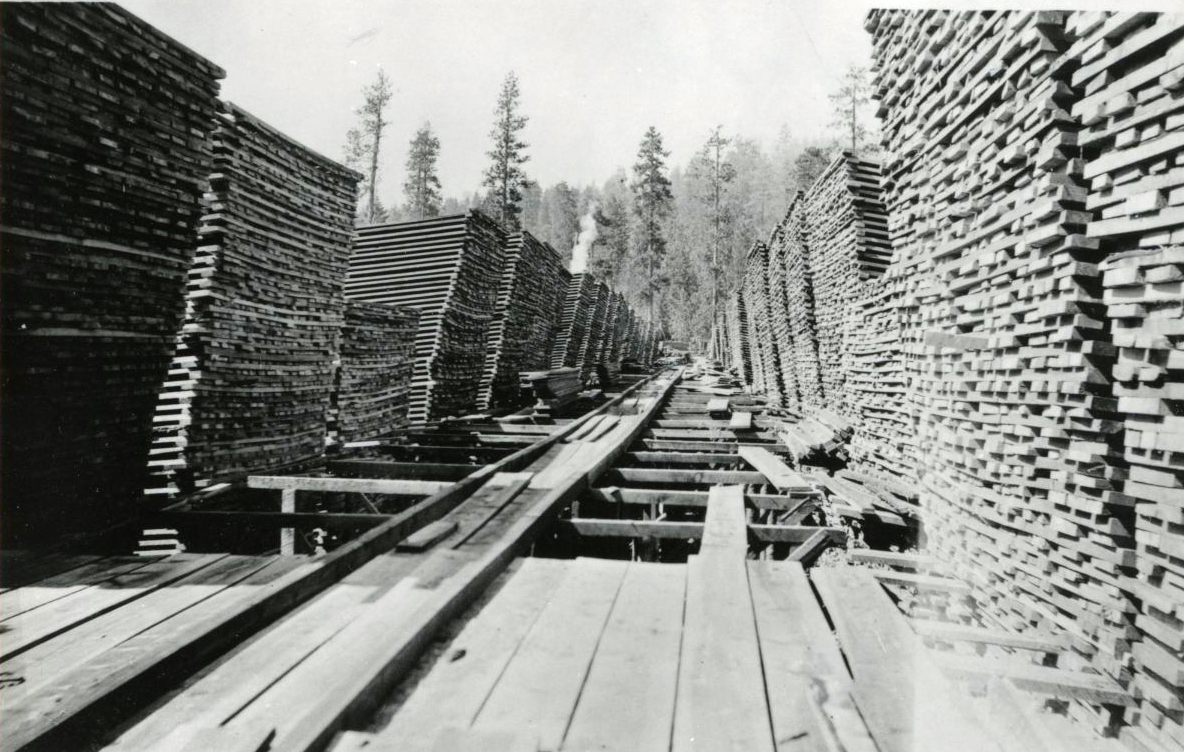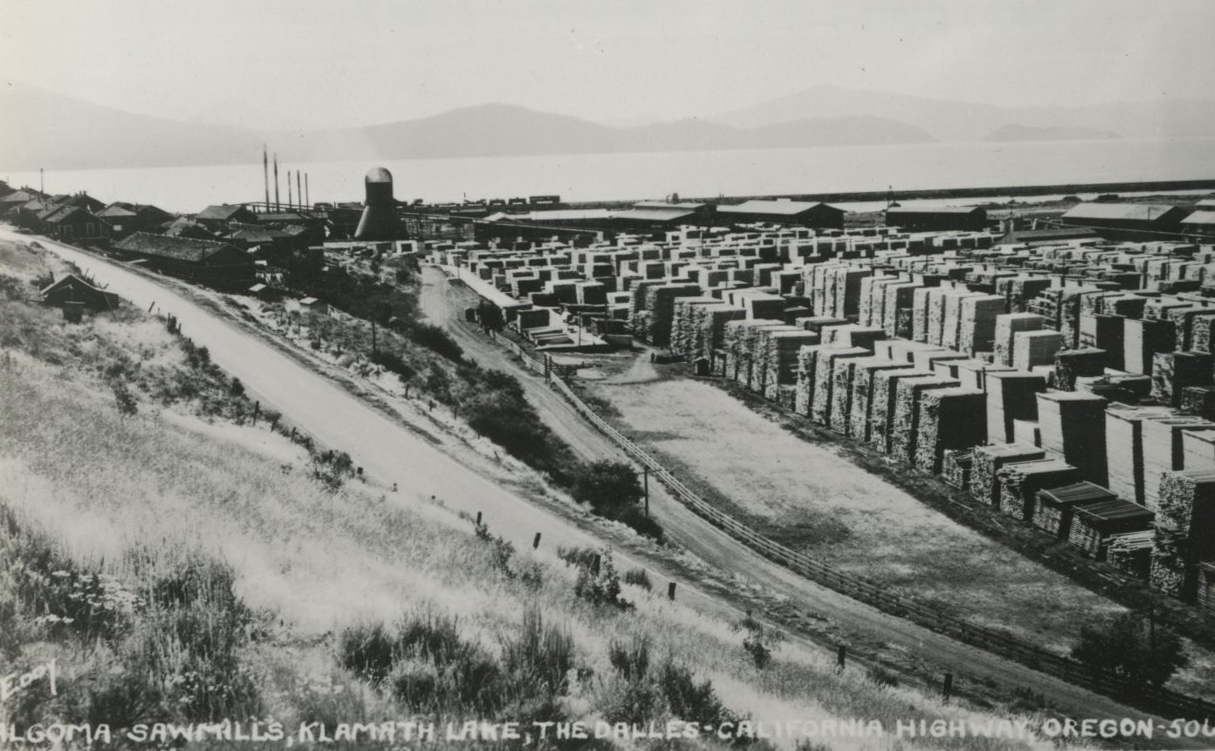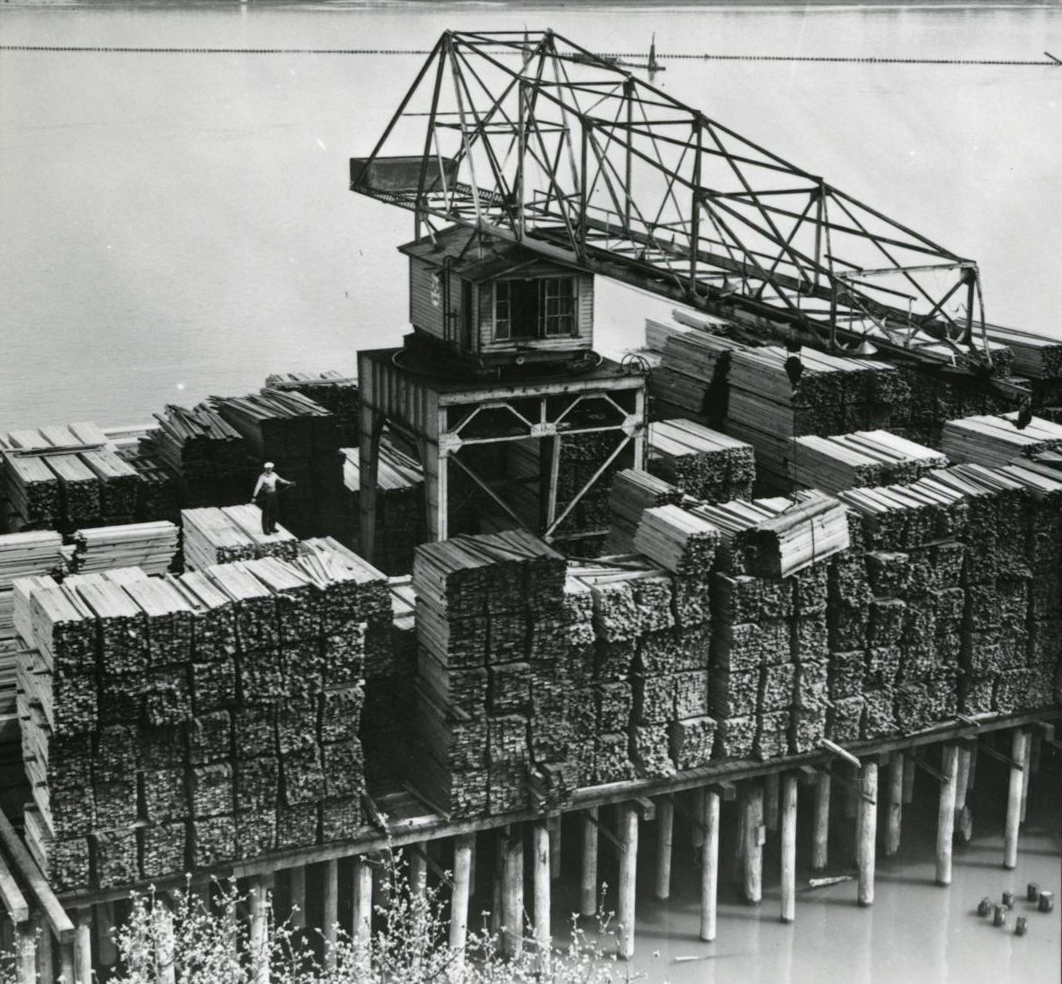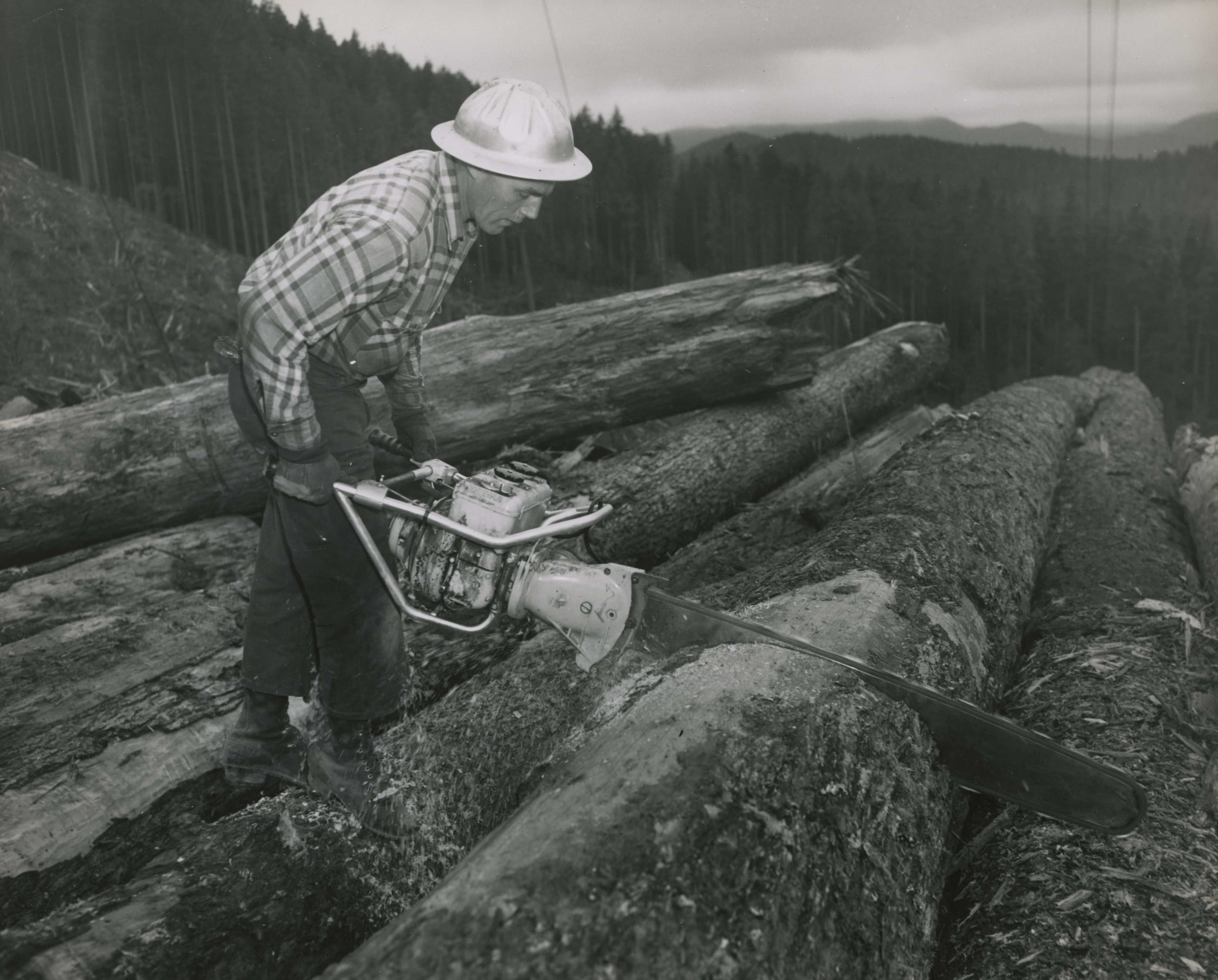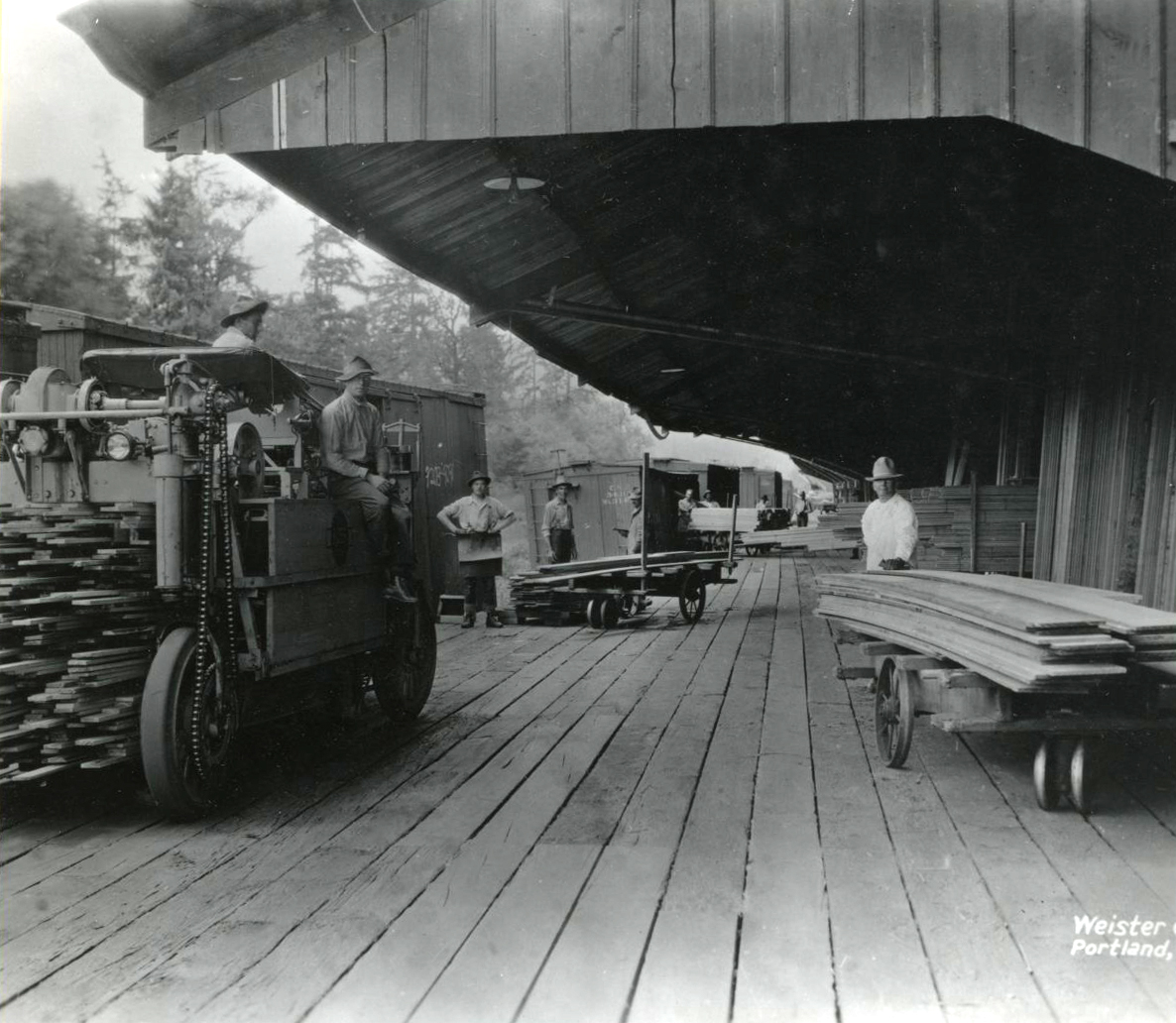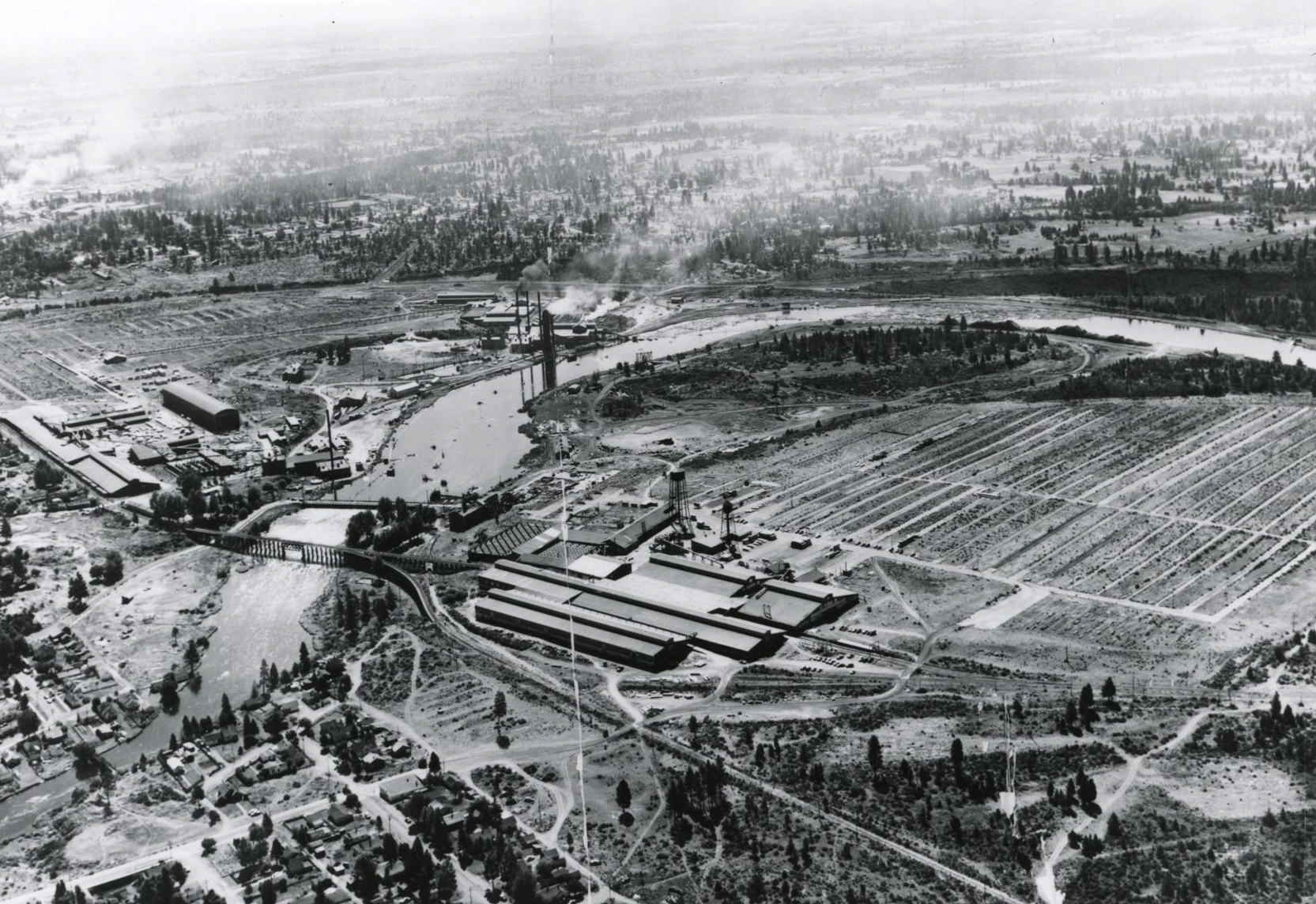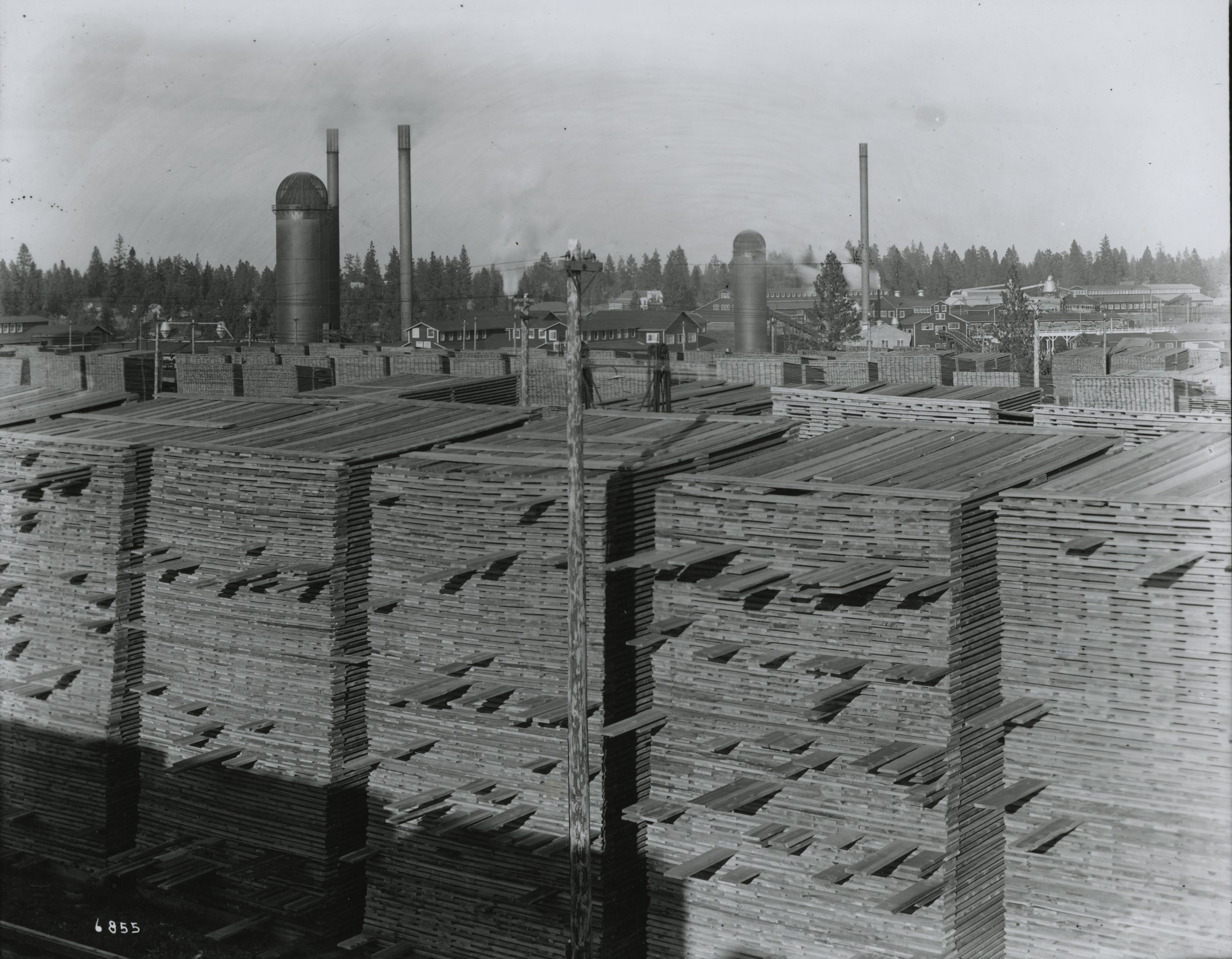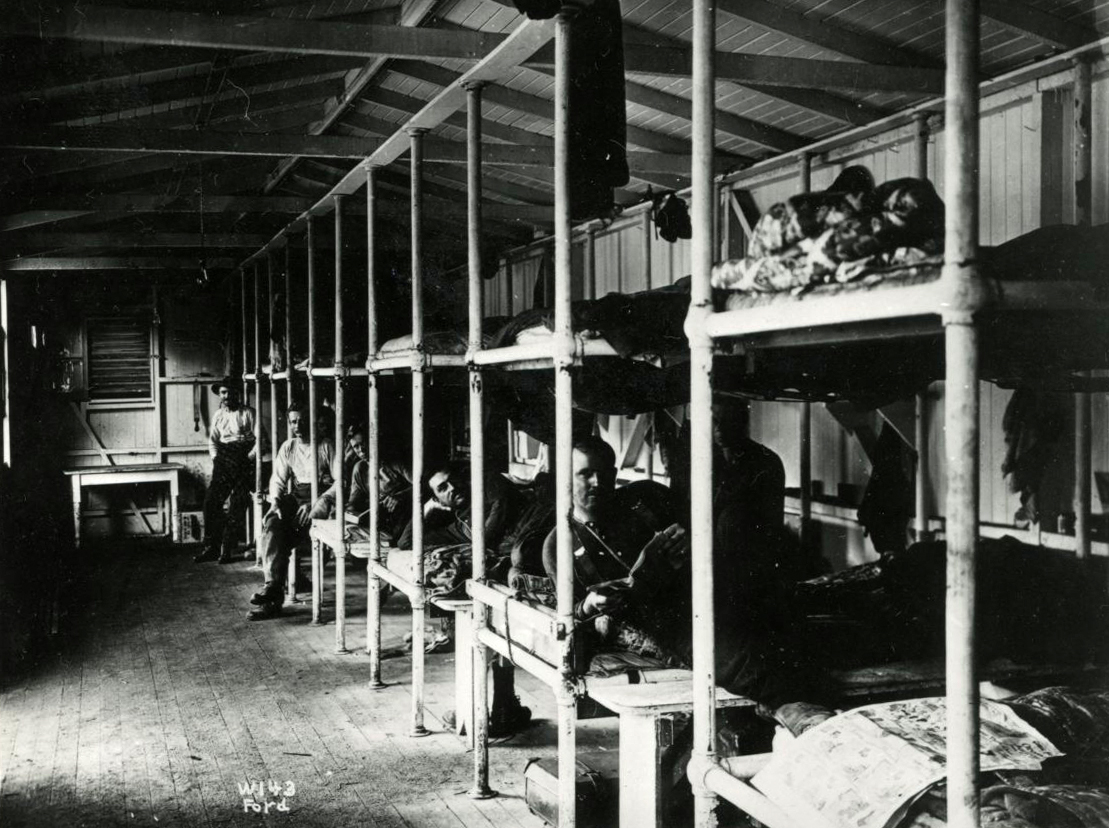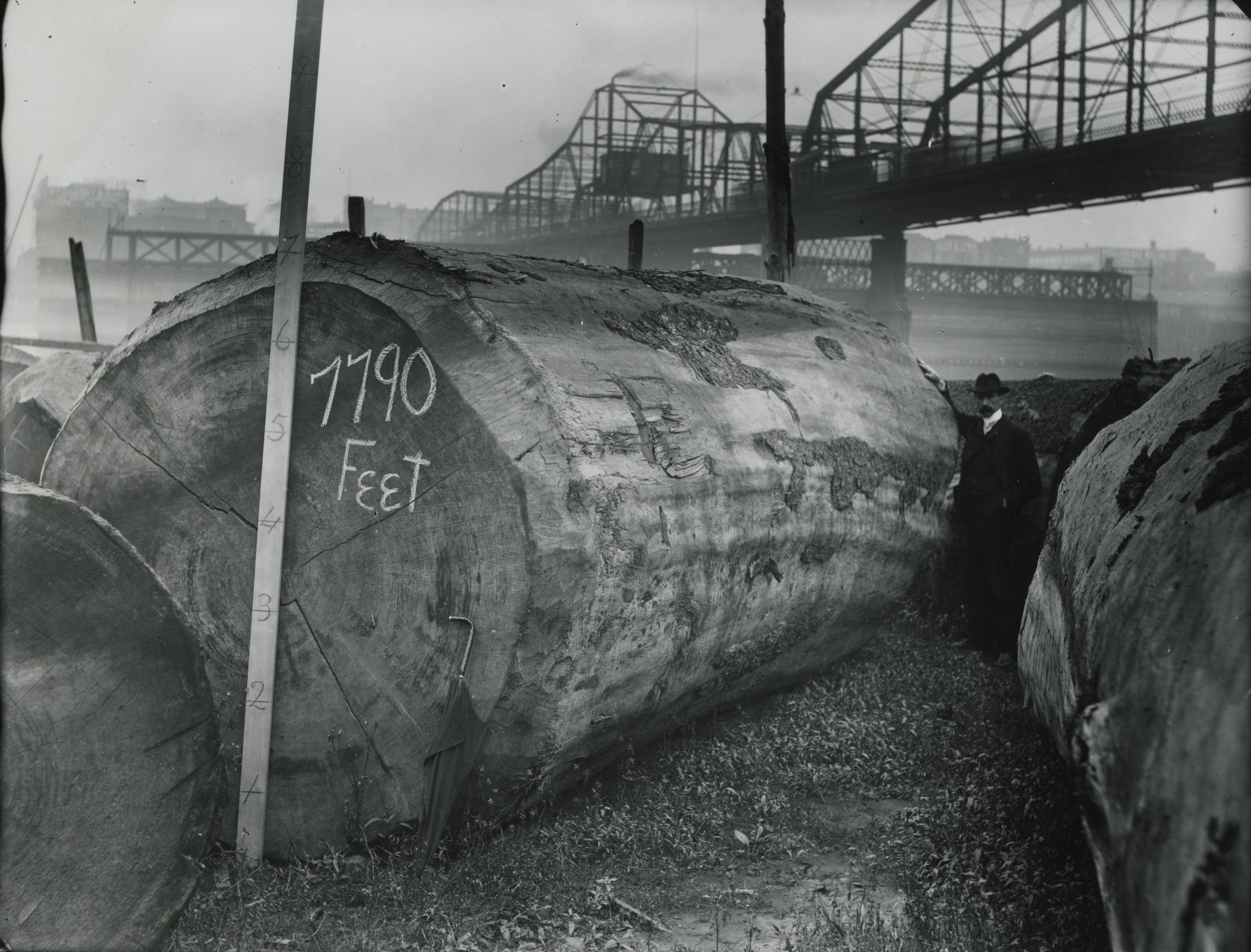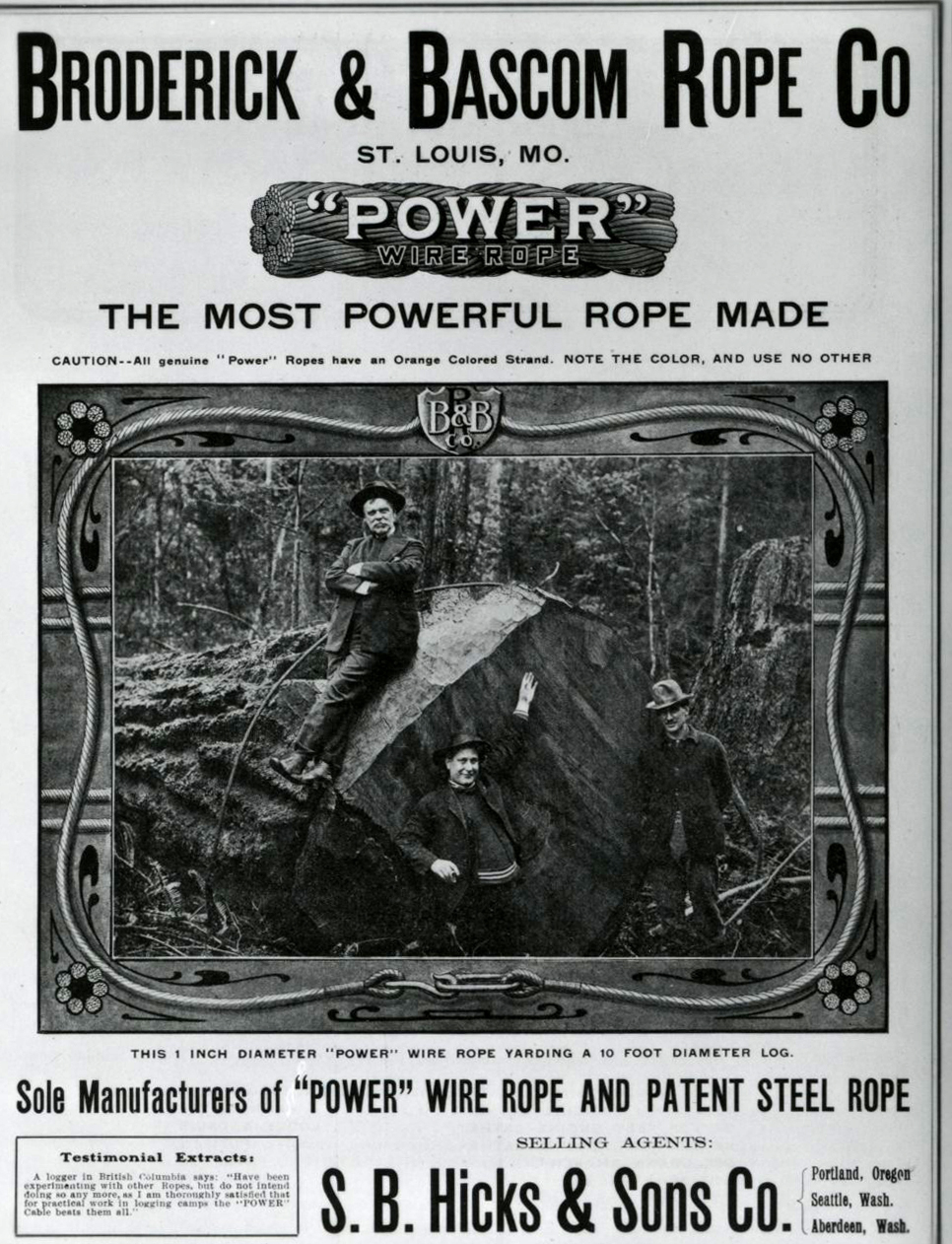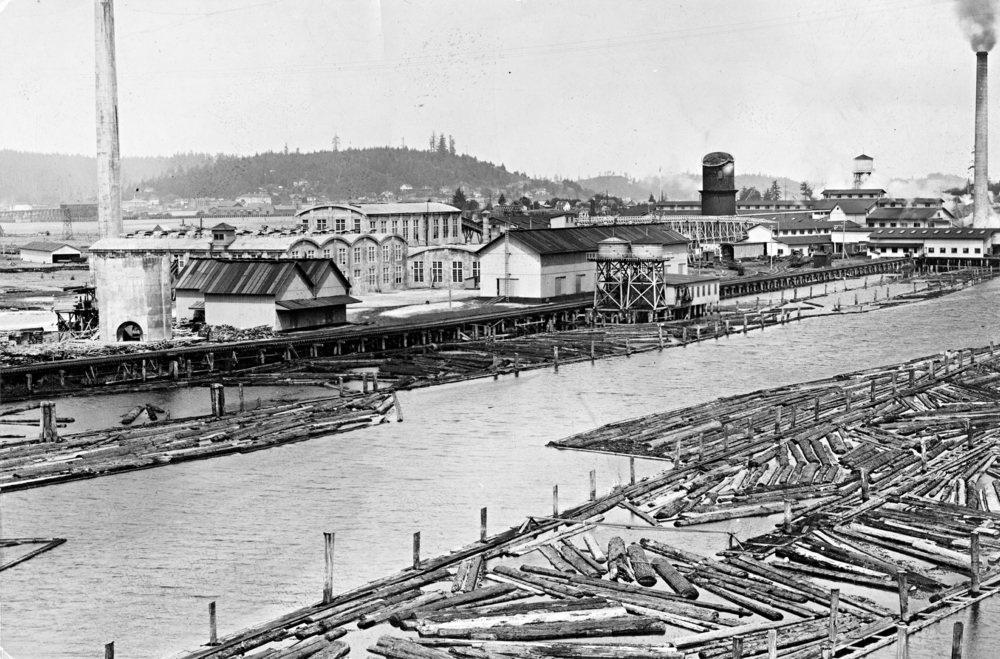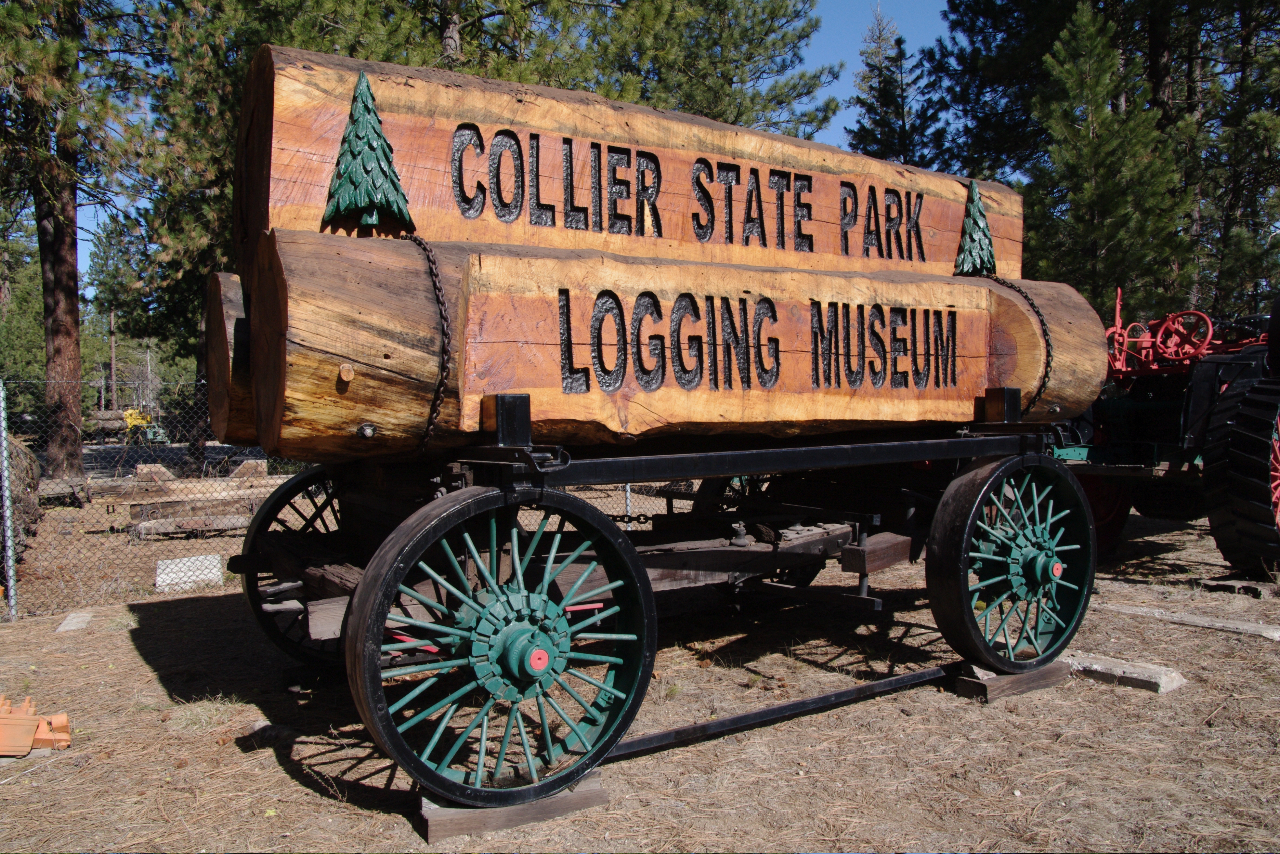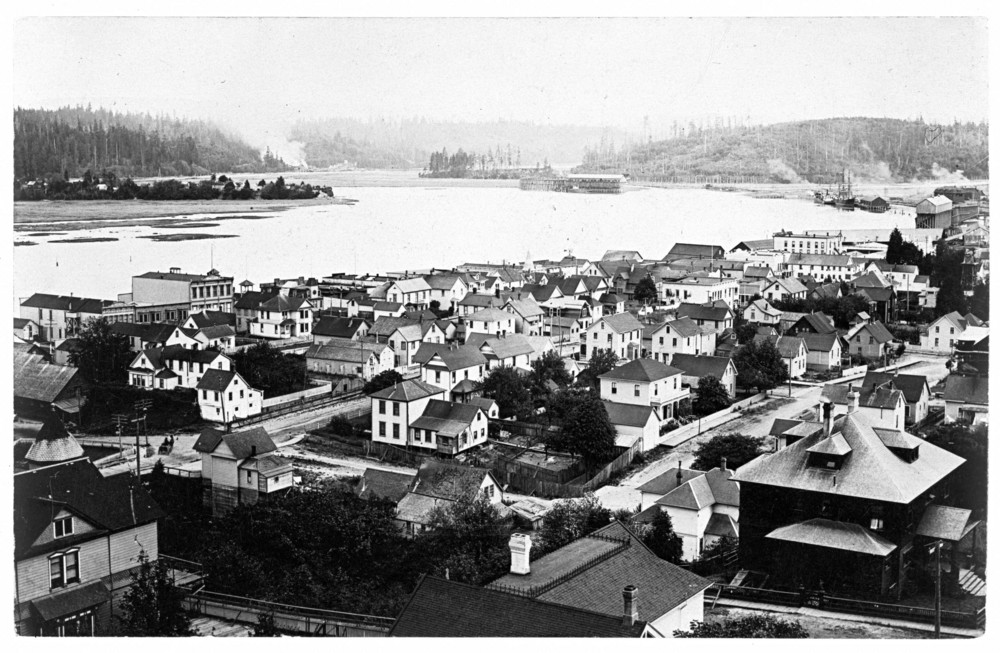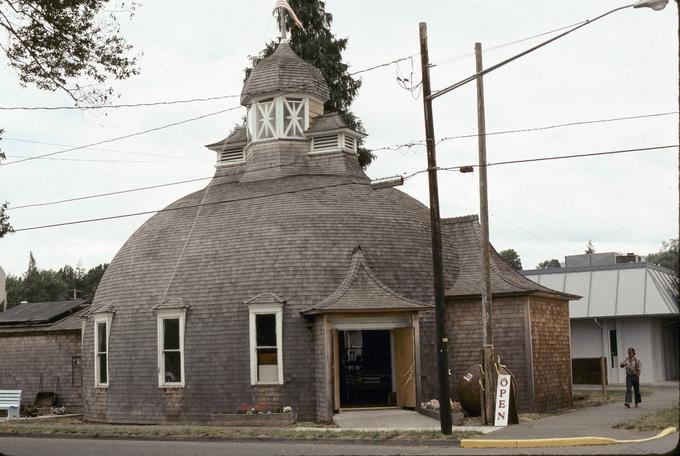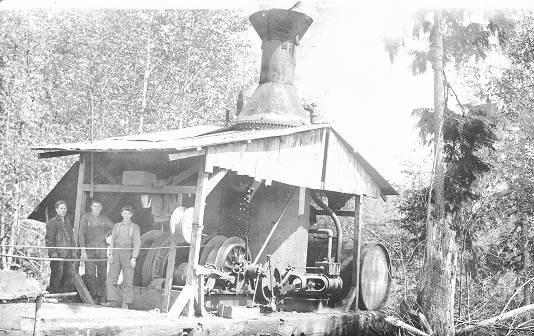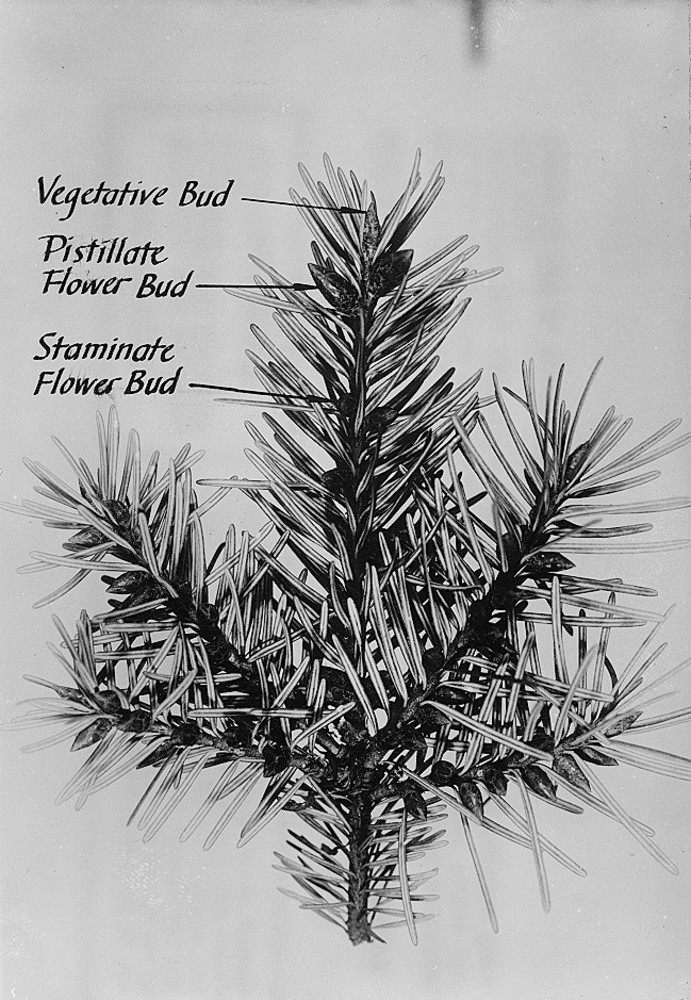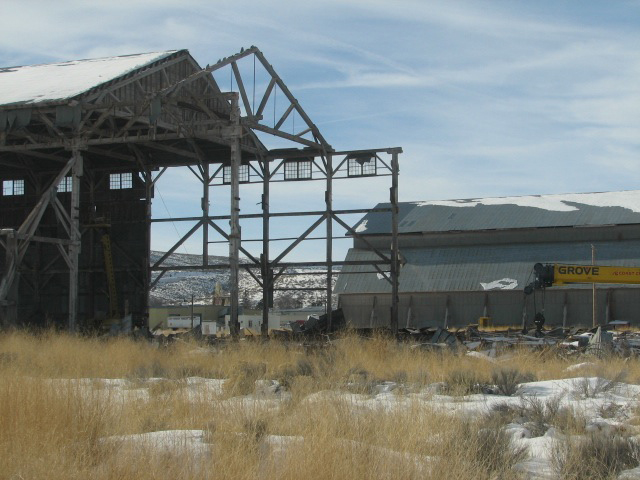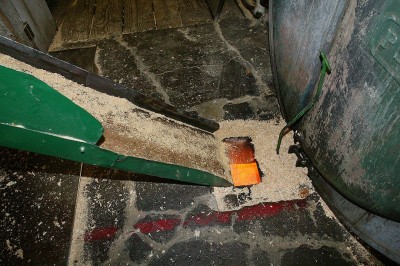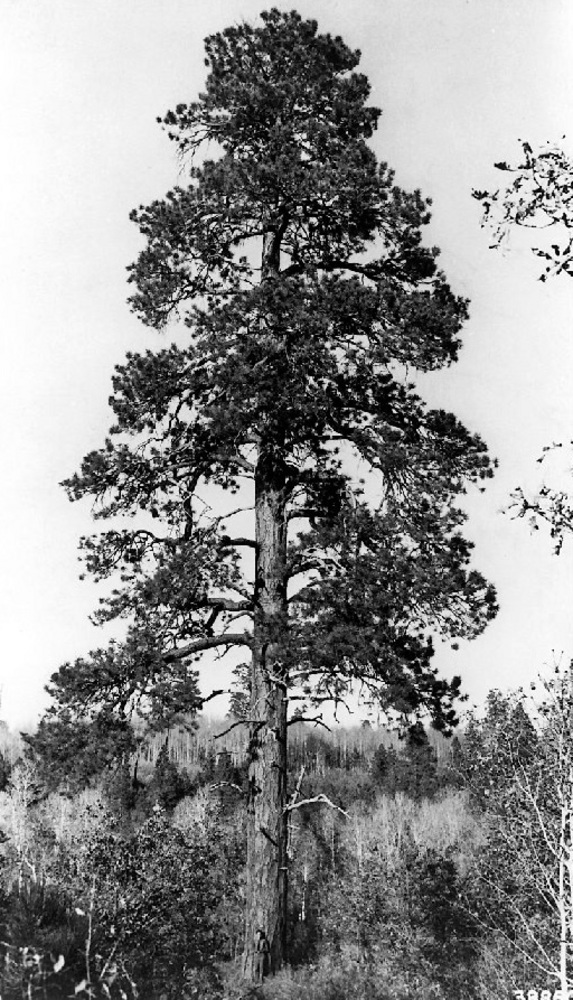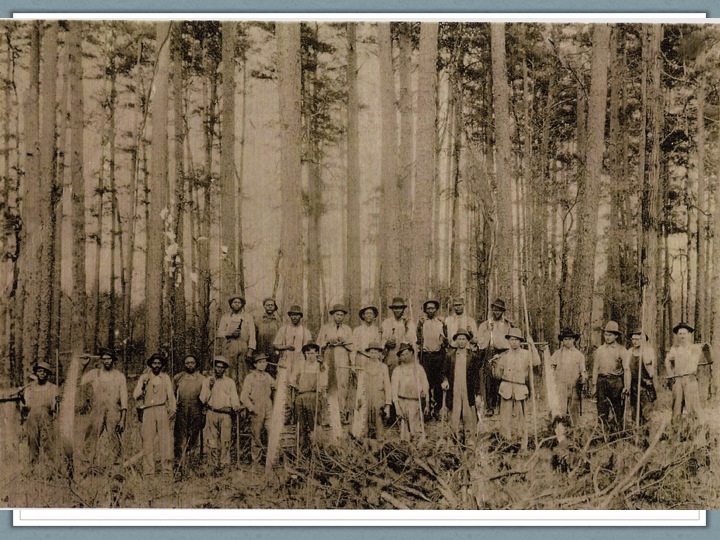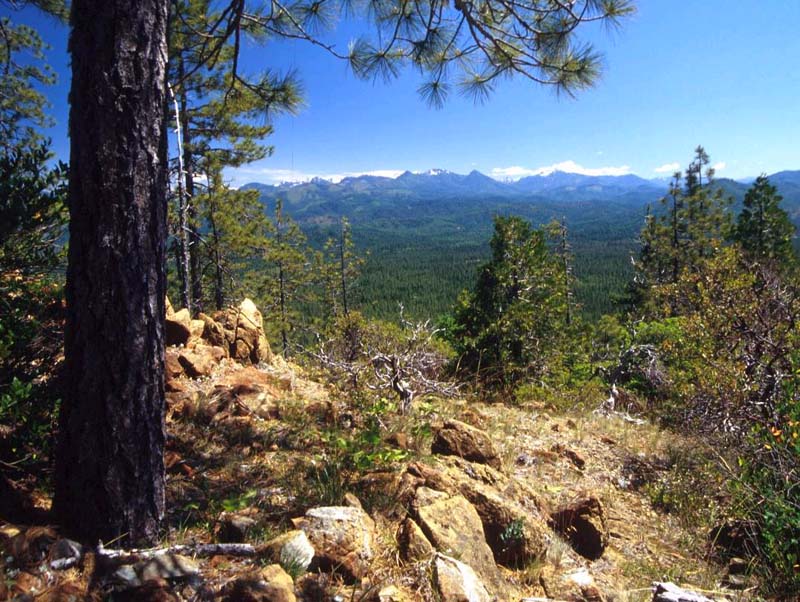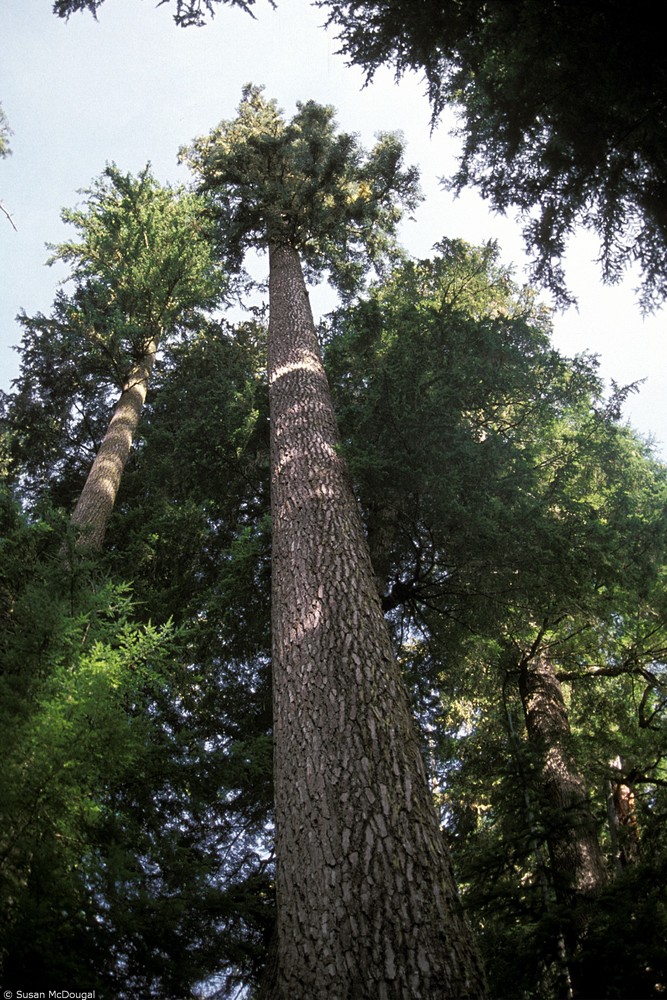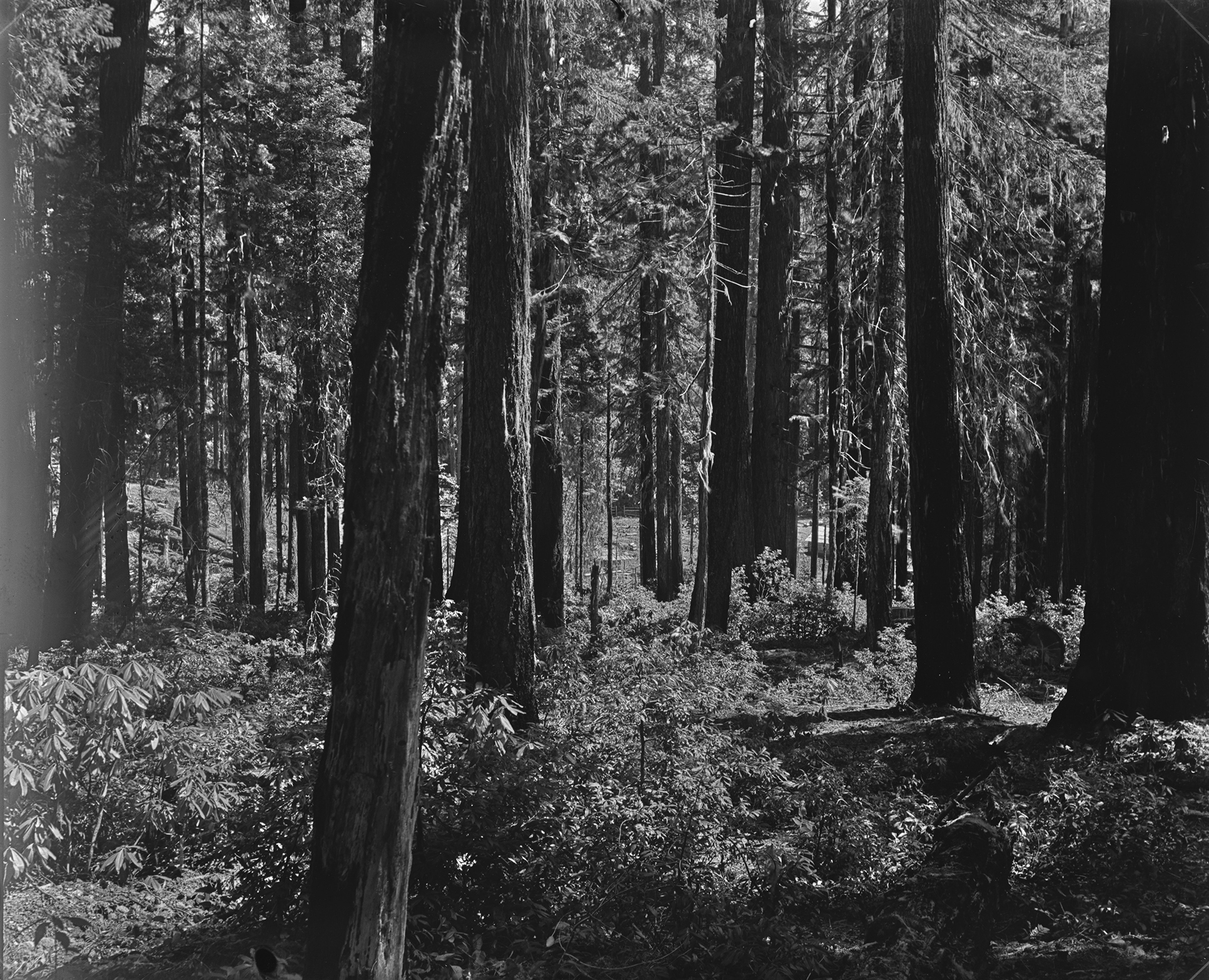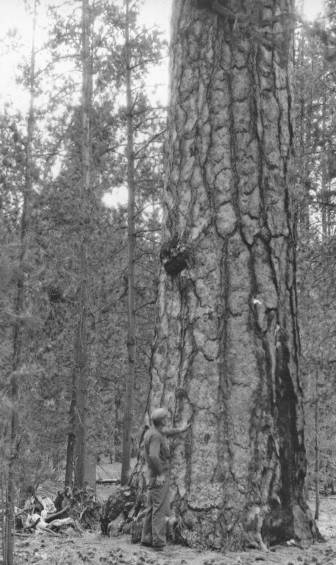Since the 1880s, long before the mythical Paul Bunyan roamed the Northwest, the timber industry has been a driving force in the economies of Oregon and Washington and British Columbia. Forests on the Oregon Coast and the lower Columbia River had attracted those in the mid-nineteenth century who wanted to capitalize on gold-rush California’s growing demand for lumber. With the development of rail lines in the 1870s and 1880s, the forested valleys of the western Cascades and the ponderosa pine stands of eastern Oregon became centers of lumber production. Washington State became the nation’s leading producer of wood products in 1910, a position that Oregon has held since 1938. With the region’s increasingly diversified economy in the twenty-first century, however, wood products are no longer among the region's top commodities.
The Northwest has been a significant regional, national, and international participant in the lumber trade since the Hudson’s Bay Company built a water-powered sawmill at Fort Vancouver in 1827. During and after Oregon’s territorial period, Coos Bay, on the southern coast, was the exemplar of a timber-dependent community. George Wasson, who used oxen to haul logs to his water-powered sawmill in 1853, initiated the Coos lumber trade. Asa Mead Simpson followed with a steam-powered mill that dominated production on Coos Bay for decades. Using cargo ships to haul lumber from his coastal mills to retail outlets in San Francisco, Simpson turned his enterprises into extractive tributaries for California markets.
With timberlands in Michigan, Minnesota, and Wisconsin rapidly diminishing during the late nineteenth century, Great Lakes timber locators prowled Northwest forests on behalf of lumbermen such as Charles Axel Smith and Frederic Weyerhaeuser, laying claim to huge timberlands for their moneyed patrons. Smith took advantage of his properties on the southern Oregon Coast to open a state-of-the-art sawmill on Coos Bay in 1908, and his ships made regular trips to the company’s finishing mill at Bay Point northeast of San Francisco. By the dawn of the twentieth century, several large mills lined Portland’s waterfront, producing sawn lumber for California and Asian markets. On the Columbia River, Portland businessman Simon Benson pioneered a new technique in the early decades of the twentieth century, using ocean-going tugboats to pull large cigar-shaped log rafts to his sawmill in San Diego.
The Great Lakes lumbermen and other investors who speculated in timberland at the turn of the twentieth century operated through railroad real estate agents and federal and state land offices to amass huge holdings. They played fast and loose with state and federal land laws to transfer thousands of acres of public land to private ownership. On Oregon’s south coast, C.A. Smith’s agents used dummy entrymen under the Homestead Act to fraudulently block up large forested acres into single units. The scheme involved company agents, who staked homestead claims for 160 acres of timber and then commuted titles to investors. Those activities attracted the attention of Secretary of the Interior Ethan Hitchcock, who appointed San Francisco attorney Francis J. Heney as special prosecutor for what became known as the Oregon Land Fraud cases. The most sensational trials involved Oregon’s U.S. Senator John Mitchell and Congressman John Williamson. A jury found Mitchell guilty of assisting a friend to fraudulently acquire timberland. He died before a court could hear his appeal. Although Williamson also was found guilty, his conviction was overturned on appeal.
The completion of transcontinental railroads to the Northwest in the 1880s extended logging and lumbering to less accessible areas, especially eastern Oregon. The Northern Pacific reached Portland in 1883, and the Oregon Short Line connected Union Pacific’s road at Granger, Wyoming, with the Columbia River at Wallula Junction in 1884, opening the Blue Mountains to timber harvesting. The Southern Pacific extended a railroad to Klamath Falls in 1909, and James J. Hill’s Great Northern Railway constructed a line up the Deschutes River Gorge to the small town of Bend in 1911.
Bend quickly became a pacesetter for ponderosa pine production when two Great Lakes firms, Brooks-Scanlon and Shevlin-Hixon, opened modern sawmills on opposite sides of the Deschutes River in 1916. With their miles of logging railroads, the companies set off nearly seventy years of pine manufacturing in what is now Bend’s upscale Old Mill District. In the Rogue River Valley, Medford-based Owen-Oregon Company built logging railroads to places such as Butte Falls, where a huge volume of pine lumber was turned out during the 1920s. Its successor, the Medford Corporation, became a vertically integrated firm in the postwar era, providing jobs and steady paychecks through the 1970s.
Northwest loggers confronted physical obstacles unknown to woodsmen who emigrated from the Great Lakes states. The size of the trees—Douglas-fir as tall as three hundred feet and ten feet in diameter—posed problems made more difficult by the rugged terrain. In Douglas-fir country, from the crest of the Cascades to the Pacific, loggers at first felled trees into waterways, where they could be floated to mills. They soon constructed corduroy roadways into timber, using teams of oxen to haul logs along skid roads to water. Loggers first used single-bitted axes to fell trees. By the 1880s, however, they were using double-bitted axes and two-man crosscut saws, a technology that remained in place until the development of gasoline-powered chainsaws in the 1940s.
Steam power came to the woods in the 1880s with the invention of the steam donkey, which used steam to power a capstan that pulled logs along the ground with a wire rope. In the first decade of the twentieth century, loggers added an aerial twist to steam-donkey logging, the high lead, allowing operators to haul logs with one end suspended in the air free from stumps and brush. The development of the high lead accelerated yarding logs and increased the incident of death and injury to logging crews.
During the twentieth century, logging companies extended railroads long distances to sources of timber, speeding the transport of logs to water’s edge or to mills. The development of heavy-duty log trucks during the 1930s gradually displaced most logging railroads by 1960, and steam donkeys gave way to gasoline and diesel-powered yarding machines during and after World War II. The most revolutionary tool by far was the powerful one-man chainsaw, which replaced two-person timber fallers and their crosscut saws.
Oregon mills had adopted steam power in the 1850s, which had greatly increased productivity. Another boost to production occurred during the 1870s, when mill owners around Coos Bay and on the lower Willamette River replaced circular saws with band saws. By the 1890s and into the twentieth century, electric-powered sawmills began appearing in major centers of production. C.A. Smith’s Big Mill on Coos Bay was an exemplar of the new technology in Oregon—the nerve center for logs harvested in the bay’s extensive timberlands, milled in one of the nation’s most modern mills, and the lumber shipped to distant ports.
Timber communities in Oregon operated in an economic environment that prospered and suffered with the price of lumber. Timber harvesting grew apace during the early 1920s, with loggers east and west of the Cascade Range pushing farther away from waterways in their quest for timber. Troubles began to emerge in 1925 when construction slowed in California, prompting slowdowns in the mills and layoffs in logging camps. Those market conditions were precursors to the collapse of primary products markets during the Great Depression of the 1930s.
Although Oregon’s lumber production experienced a slight increase in 1929, the following months witnessed the near total failure of wood product markets. Unemployment rolls exploded, with the West Coast Lumbermen’s Association reporting in 1931 that its sawmills were operating at 38 percent of capacity. The state’s lumber economy improved slightly in the late 1930s, when the Works Progress Administration provided jobs to a sizable number of loggers and mill workers in timber-dependent communities.
Despite defense related increases in 1939-1940, the lumber trade remained lethargic until Japan bombed Pearl Harbor on December 7, 1941, an event that triggered immediate military orders for lumber and the drafting of young men into the armed forces. What followed was a critical labor shortage in the woods and mills, and large numbers of women entering the workforce in wood products plants. Paul McNutt, chair of the War Manpower Commission, declared logging the “Number 1 manpower problem in the West.” He ordered workers to remain in “essential occupations,” a directive largely ignored as they sought better-paying jobs.
The months and years that followed the end of the war in August 1945 witnessed a great boom in logging and lumbering—new sawmills, a proliferation of gyppo operations, and a heady optimism in timber towns that the good times were here to stay. With California’s voracious construction market consuming much of Oregon’s production through the 1950s and 1960s, jobs were plentiful, despite seasonal layoffs and occasional downturns in the market.
The postwar years witnessed the increasing concentration of timberland ownership and lumber manufacturing. Most important along the North Pacific Coast was the emergence of the Georgia-Pacific Corporation. From a small financial base in Augusta, Georgia, the company began making large purchases of mills and timberland. Between 1956 and 1959, Georgia-Pacific bought the Hammond Lumber Company and 127,000 acres of timber in northern California, the Coos Bay Lumber Company and 120,000 acres, the Booth-Kelly Company’s 200,000 acres in Springfield, and the C.D. Johnson Company and 120,000 acres in Toledo. Georgia-Pacific’s huge acquisitions, sharply increased harvests, and timber sales to other mills in order to create a cash flow for its purchases, revolutionized the West Coast lumber industry.
During the first half of the twentieth century, a few investors—interested in the exclusive control of their work forces—purchased lush stands of timber in Oregon and built mills, logging railroads, and houses for their workers. One of the largest company towns was the Kinzua operation in Wheeler County. Established in 1928 as a ponderosa pine production center, Kinzua housed 700 residents at its peak. With the harvestable timber exhausted, the mill closed in 1978, and the town was demolished. Valsetz, a company town established by Cobbs and Mitchell in the Coast Range west of Monmouth, opened in 1919 with a school, post office, and other accouterments of a viable community, characteristics shared by all company towns. Boise Cascade purchased the timber and town in 1959, tore up its railroad in the 1970s, and then razed the town in 1984. Maxville in northern Wallowa County represented the efforts of Southern investors, who established the town in 1923. The owners brought with them skilled loggers and mill workers, including a sizable number of African Americans. Frank Gilchrist, from Mississippi, established a town and mill operation in 1938 in northern Klamath County. Astride Highway 97, the town of Gilchrist gained prominence as Oregon’s last company town when the family sold the town and forestlands to Crown Pacific in 1991.
During the 1950s, public and private foresters promoted the principle of “conversion,” turning what they considered decadent old-growth forests into fast-growing new stands with shorter harvesting rotations. An article of faith among private and federal foresters, especially in Oregon with its sizable volume of virgin timber, the practice produced record harvests, most of it on private land. Then, with private timber supplies diminishing in the late 1960s, corporate lumbermen put pressure on the Forest Service and the Bureau of Land Management to raise harvesting rates. The federal agencies, in turn, aggressively promoted clear-cutting as a scientifically sound practice and increased the use of chemicals as a forest-management tool to control competing brush in newly planted plantations.
Challenges to this strategy developed slowly in the 1970s with environmentalists pressing courts to invoke the Endangered Species Act and similar laws that questioned the commodity management of federal forests. The heaviest timber harvests involved private lands, but there were few regulations on that ownership class to protect forests and waterways. Although the Oregon legislature passed the nation’s first forest practices act in 1941 (revised in 1971), the legislation had no teeth. The laws were drafted by the lumber industry to stave off the threat of federal regulation of harvest practices, including clear-cutting. Federal environmental regulations, however, began to take a toll on both public and private land management when federal regulators banned the use of DDT in 1972 and the herbicide 2,4,5-T in 1979 to keep brush from competing with Douglas-fir and other tree species. Those controversies, however, paled in comparison with the effect the northern spotted owl had on the industry in the early 1990s.
When District Judge William Dwyer prohibited national forest timber sales in potential spotted owl habitat in May 1991, he set off years of litigation over animals and plants that had been listed as endangered. In the case of the spotted owl, classified as an indicator species, Dwyer accused the Forest Service and the U.S. Fish and Wildlife Service of failing “to comply with the laws protecting wildlife.” His decision, among other factors, sharply reduced timber harvests on federal land, the greatest reductions taking place in Oregon and Washington. Forest Service harvests in Oregon plummeted from a volume of 2 billion board feet in 1990 to a low of 245 million board feet in 2000. Oregon’s national forest timber sales in 2015 totaled about 55 million board feet, most of it involving thinning sales.
The curtailment of federal timber sales in the 1990s followed a decade of record harvests on the national forests, especially in Oregon. Between the late 1980s and 2000, the harvest from federal forests fell by more than 90 percent, while cutting on all other forests fell by only 20 percent. A statistic from fiscal year 2008 indicates that forest industry land provided 74 percent of all forest products in the state. (The total harvest of Oregon timber in 2015 was just under 4 billion board feet.)
While Oregon’s emerging high-tech economy offset much of the decline in lumber production, environmental restrictions hurt communities distant from the I-5 corridor. Other factors explain some of the decline in timber industry employment, especially technological changes in the woods and mills making it possible for fewer workers to turn out an increasing volume of wood products. New logging equipment, especially yarding machines, sharply reduced labor as a factor in harvesting. The most significant technological changes since the 1980s, however, involved sawmills where laser-controlled, automated equipment has drastically reduced employment. As a consequence, Oregon’s employment in the timber industry has declined precipitously since the late 1970s, along with the diminishing importance of the wood products industry in the state’s economy. That trend is also true of Washington and the Canadian province of British Columbia.
-
![Loggers in Clatsop County]()
Loggers in Clatsop County.
Loggers in Clatsop County Courtesy Oreg. Hist. Soc. Research Lib., OrHi93132
-
![]()
Loading logs, 1939.
Courtesy Oreg. Hist. Soc. Research Lib., 26315
-
![]()
Trimming off branches with a chainsaw, Pacific Northwest.
Courtesy Oreg. Hist. Soc. Research Lib., 023400
-
![]()
The cooking crew at the Coos Bay area lumber company, c. 1914.
Courtesy Oreg. Hist. Soc. Research Lib., 017047
-
![]()
A logger rides a Bosun's chair up spar tree to set rigging.
Courtesy Oreg. Hist. Soc. Research Lib., 016343
-
![]()
High-lead logging skyhook.
Courtesy Oreg. Hist. Soc. Research Lib., 54483
-
![]()
Log flume in the Columbia River Gorge.
Courtesy Oreg. Hist. Soc. Research Lib., 016296
-
![]()
Shaver and Sarah Dixon log raft.
Courtesy Oreg. Hist. Soc. Research Lib., 45968
-
![]()
Steamboat, the Veteran, pulls a cigar raft of logs on the Columbia.
Courtesy Oreg. Hist. Soc. Research Lib., 12263
-
![]()
Logs awaiting spring flood to carry them to Columbia River.
Courtesy Oreg. Hist. Soc. Research Lib., OrH4698
-
![]()
Log raft from Oregon to San Diego.
Courtesy Oreg. Hist. Soc. Research Lib., OrHi79635
-
![]()
Log rafts on the Willamette River, 1947.
Courtesy Oreg. Hist. Soc. Research Lib., OrHi7887
-
![]()
Log raft under construction.
Courtesy Oreg. Hist. Soc. Research Lib., Gi7889
-
![]()
Priest River log jam, 1948.
Courtesy Oreg. Hist. Soc. Research Lib., acc9511
-
![]()
Sternwheelers with lumber raft, Columbia River, Astoria.
Courtesy Oreg. Hist. Soc. Research Lib., 4630
-
![]()
Logs plunge downhill into the water, Pope & Talbot, Dallas, Oregon.
Courtesy Oreg. Hist. Soc. Research Lib., 0327A062
-
![]()
Log pond, Gilchrist Lumber Co., c. 1938.
Courtesy Oreg. Hist. Soc. Research Lib., 022976
-
![]()
Log raft in Rinearson Slough, Columbia County.
Courtesy Oreg. Hist. Soc. Research Lib., 4697
-
![]()
Sorting table, Falls, Oregon.
Courtesy Oreg. Hist. Soc. Research Lib., photo file 648A
-
![]()
Floating logs, Pacific Northwest.
Courtesy Oreg. Hist. Soc. Research Lib., 21760
-
![]()
Crossett Western Lumber Co., Wauna, Oregon.
Courtesy Oreg. Hist. Soc. Research Lib., 016313
-
![]()
Lumberyard at R.W. Tower Sawmill, Keno, Oregon, c.1912.
Courtesy Oreg. Hist. Soc. Research Lib., 016078
-
![]()
Stacks of lumber, Algoma, Oregon, on the Dalles-California near Klamath Lake.
Courtesy Oreg. Hist. Soc. Research Lib., 020768
-
![]()
Crane stacks a sling of lumber awaiting shipment at Pope & Talbot Lumber Co., St. Helens, 1940.
Courtesy Oreg. Hist. Soc. Research Lib., 013676
-
![]()
Oregon Sitka spruce log.
Courtesy Oreg. Hist. Soc. Research Lib., photo file 679
-
![]()
Edward Himes lumber yard.
Courtesy Oreg. Hist. Soc. Research Lib., photo file 678B
-
![]()
Early chainsaw.
Courtesy Oreg. Hist. Soc. Research Lib., 54484
-
![]()
Crossett Western Lumber Co., Wauna, Oregon.
Courtesy Oreg. Hist. Soc. Research Lib., 01637
-
![]()
Brooks-Scanlon, Bend, Oregon.
Courtesy Oreg. Hist. Soc. Research Lib., 58308
-
![]()
Brooks-Scanlon, Bend, Oregon.
Courtesy Oreg. Hist. Soc. Research Lib., Gi6855
-
![]()
Men in bunk beds at the Larkin-Green Logging Co. camp, c.1915.
Courtesy Oreg. Hist. Soc. Research Lib., 020904
-
![]()
A cut log from a tree nearly 7 feet wide, near the Morrison Bridge, Portland.
Courtesy Oreg. Hist. Soc. Research Lib., OrHi7774
-
![]()
Ad for power wire rope in the Timberman, 1904.
Courtesy Oreg. Hist. Soc. Research Lib., 35179
-
![]()
Ad for Hercules logging jacks in the Timberman, 1902.
Courtesy Oreg. Hist. Soc. Research Lib., 35175
Related Entries
-
![Andrew B. Hammond (1848-1934)]()
Andrew B. Hammond (1848-1934)
Sensing opportunity following the Panic of 1893, Montana businessman An…
-
![C.A. Smith Lumber Company]()
C.A. Smith Lumber Company
Charles Axel Smith became, for a time, one of Oregon's most powerful lu…
-
![Collier Logging Museum and State Park]()
Collier Logging Museum and State Park
Collier Memorial State Park and Logging Museum, located at the confluen…
-
![Company Towns]()
Company Towns
While there have been scores of industrial settlements and communities …
-
![Coos Bay]()
Coos Bay
The Coos Bay estuary is a semi-enclosed, elongated series of sloughs an…
-
![Coos County Logging Museum]()
Coos County Logging Museum
Coos County’s Logging Museum in Myrtle Point is easily recognized by it…
-
![Donkey engine]()
Donkey engine
A donkey engine was an integrated machine consisting of a powerplant an…
-
![Douglas-fir]()
Douglas-fir
Douglas-fir (Pseudotsuga menziesii), perhaps the most common tree in Or…
-
![Gilchrist]()
Gilchrist
Gilchrist, in northern Klamath County, located along U.S. Highway 97 ab…
-
![Gyppo Logging in Oregon]()
Gyppo Logging in Oregon
The term “gyppo logging” refers to timber harvesting conducted by small…
-
Hines and the Edward Hines Lumber Company
In the mid-1920s, large sawmill owners in the United States found a new…
-
![Hull-Oakes Lumber Company and mill]()
Hull-Oakes Lumber Company and mill
The historic steam-powered sawmill complex of the Hull-Oakes Lumber Com…
-
![John Hipple Mitchell (1835-1905)]()
John Hipple Mitchell (1835-1905)
John Hipple Mitchell was a Portland lawyer and politician whose long ca…
-
![Kinzua (town)]()
Kinzua (town)
In 1909, lumberman E.D. Wetmore traveled through Oregon buying up vast …
-
![Maxville]()
Maxville
Maxville, in northeast Oregon east of the town of Wallowa, was home to …
-
![National Forests in Oregon, 1892 to 1933]()
National Forests in Oregon, 1892 to 1933
The first forest reserves in the state were established in 1892-1893, a…
-
![Noble fir]()
Noble fir
Noble fir (Abies procera), also known as red fir or larch, is indeed no…
-
![Oregon-American Lumber Company]()
Oregon-American Lumber Company
The Oregon-American Lumber Company (1917-1934) and its successors—the O…
-
![Oregon Forests and Climate Change]()
Oregon Forests and Climate Change
How climate change affects Oregon forests and how those forests affect …
-
![Oregon Land Fraud Trials (1904-1910)]()
Oregon Land Fraud Trials (1904-1910)
During the summer of 1905, while visitors enjoyed the amusements of the…
-
![Ponderosa pine]()
Ponderosa pine
Ponderosa pine (Pinus ponderosa)—also known as yellow, western yellow, …
-
![Shasta red fir]()
Shasta red fir
The Shasta red fir (Abies magnifica var. shastensis), or silvertip, in …
-
![Sitka spruce]()
Sitka spruce
Sitka spruce (Picea sitchensis) is also known as the coast or tidewater…
-
![U.S. Bureau of Land Management]()
U.S. Bureau of Land Management
The Bureau of Land Management (BLM) administers over 15.7 million acres…
Related Historical Records
Map This on the Oregon History WayFinder
The Oregon History Wayfinder is an interactive map that identifies significant places, people, and events in Oregon history.
Further Reading
Kenneth Ames, with senior author Herbert G.D. Maschner, Peoples of the Northwest Coast: Their Archaeology and Prehistory, (London: Thames and Hudson Ltd., 1999)
Paul W. Hirt, A Conspiracy of Optimism: Management of the National Forests Since World War Two (Lincoln: University of Nebraska Press, 1994)
Jeffrey M. LaLande, Medford Corporation: A History of an Oregon Logging and Lumber Company (Medford: Medford Corporation, 1979)
Nancy Langston, Forest Dreams, Forest Nightmares: The Paradox of Old Growth in the Inland Northwest (Seattle: University of Washington Press, 1995)
William G. Robbins, Hard Times in Paradise: Coos Bay, Oregon, Second Edition (Seattle: University of Washington Press, 2007)
__________, Landscapes of Promise: The Oregon Story, 1800-1940 (Seattle: University of Washington Press, 1997)
__________, Landscapes of Conflict: The Oregon Story, 1940-2000 (Seattle: University of Washington Press, 2004)
__________, Lumberjacks and Legislators: Political Economy of the Lumber Industry, 1890-1941 (College Station: Texas A & M University Press, 1982)
Oregon’s Timber Harvests: 1849-2004, compiled by Alicia Andrews and Kristin Kutara, Oregon Department of Forestry (2005)
"Timber Sales." Oregon Department of Forestry.

